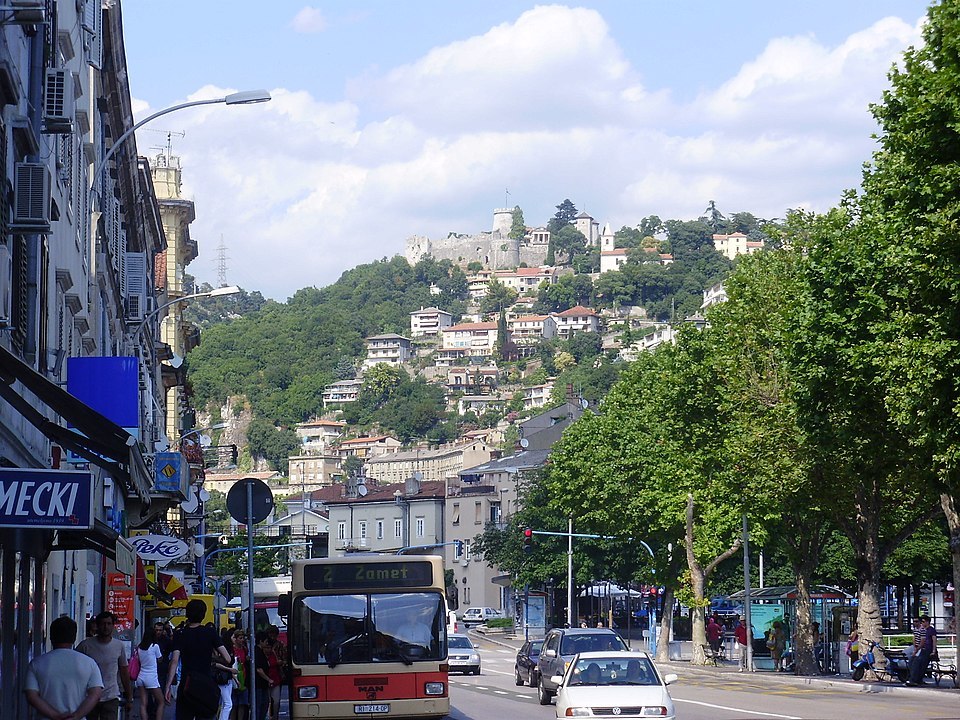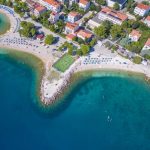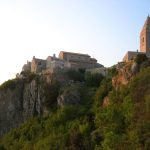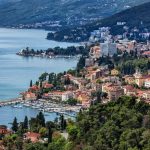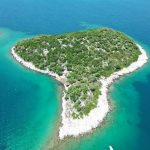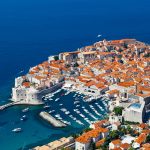Exciting Kvarner capital Rijeka is unique on the Croatia coast. A modern metropolis with an Austro-Hungarian center, a port, airport, luxury hotels, beaches, museums + more.
- Rijeka, Croatia, Capital of Kvarner
- Where is Rijeka? Map of Rijeka
- Where to Stay: Hotels, Hostels, Camping, accommodation
- Beaches in Rijeka
- Weather
- Is Rijeka Worth Visiting? What to do in Rijeka
- City centre, Old Town, Korzo, Trsat castle
- Where to eat? Rijeka restaurants
- Where to drink? Bars and cafes
- How to get to Rijeka: Port, Cruise, Ferry, Flights, Airport, Fly, Train, Bus
- Day trips from Rijeka: Venice, Dubrovnik, Trieste, Zagreb, Plitvice, Opatija, Islands
- Rijeka Football (soccer)
- Study in Rijeka: University for International Students
Rijeka, Croatia, Capital of Kvarner
Sitting centrally, overlooking the vast Kvarner Bay, there is no other city in Croatia like Rijeka. Emphatically, it’s unique. Stretching far along the coast, it’s a city with brilliant beaches, resorts and hotels. Moreover, ferries cruise daily from its major port, linking Rijeka to idyllic island locations. However, this is anything but a typical seaside city of Croatia.
Port city of Rijeka
Down the Croatian coast, the land slips gently into the sea. Consequently, beaches welcome paddling of the youngest feet. But, not in central Rijeka. As a matter of fact, the land here plunges into the Adriatic. So much so that Croatia’s greatest deep water port is here. Furthermore, the city was – on and off – the largest port of the Kingdom of Hungary and the Austro-Hungarian Empire.
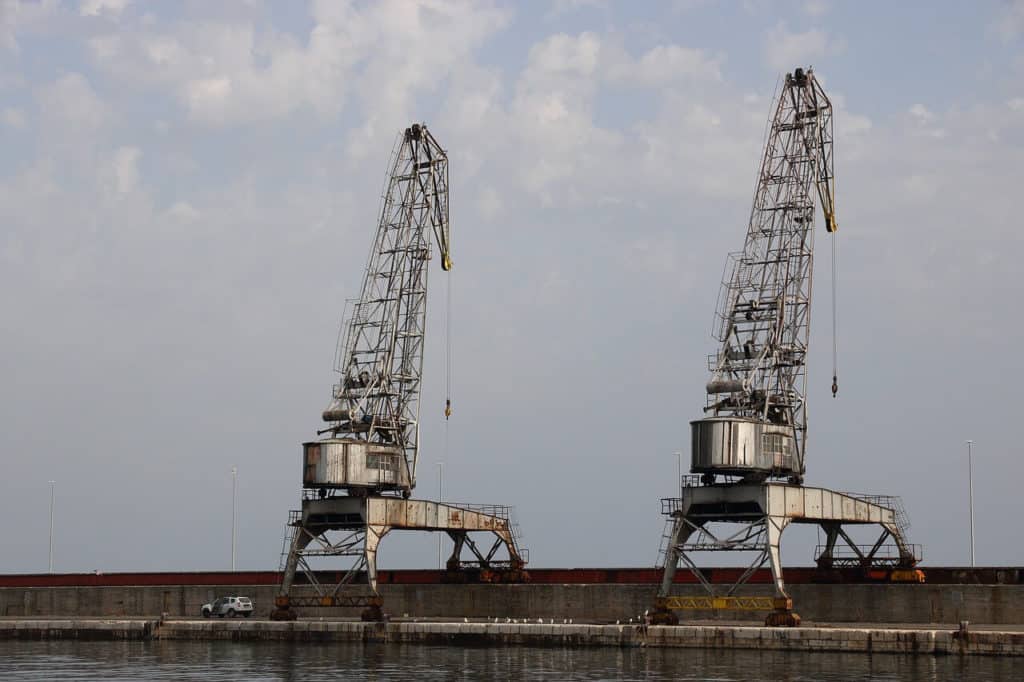
These days, Rijeka serves none but her home nation. Indeed, she acts as the capital of the Kvarner region (Primorje-Gorski Kotar County). But, the empires of old have left an indelible mark. Owing to past occupations, instead of a vista of a typical Mediterranean town, Rijeka looks very different. In place of rustic stone and green sun shutters, grand Austro-Hungarian palaces line the streets. In these respects, the city looks more like one of continental, northern Croatia.
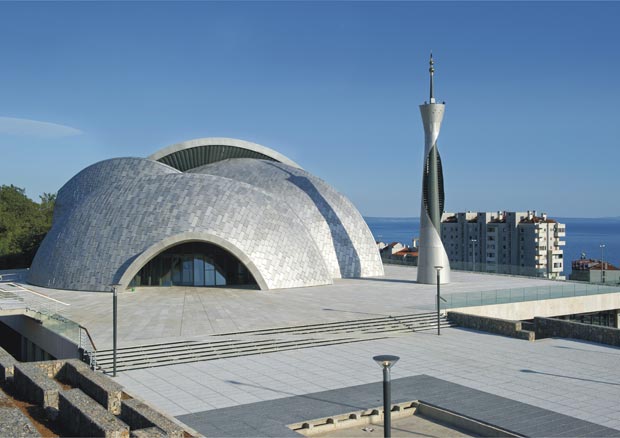
The port is still active today. And, around it, the tell-tale signs of a vast industrial past. Moreover, modern residential tower blocks climb up nearby foothills. Obviously, this is a city that expanded fast, accommodating the workers needed. For the most part, Rijeka is an anomaly. In short, it looks like a modern, continental metropolis, planted incongruously on the shore. Subsequently, this city is the best of both worlds. And much more besides.
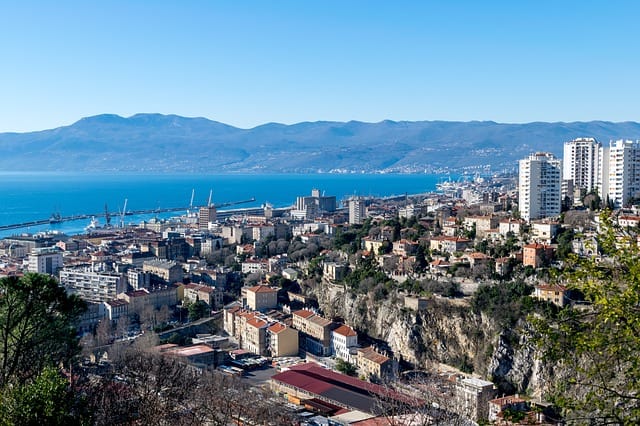
Where is Rijeka? Map of Rijeka
Rijeka is a coastal city in Croatia that sits centrally on the Kvarner Bay shore in the north of the Adriatic sea. Its coordinates are 45.3271° N, 14.4422° E.
The land that is now Croatia has changed the names of its regions and counties over time. However, we can best explain where is Rijeka if we simplify things. The coast of Croatia is traditionally made up of three regions. The Adriatic peninsula in the north-west of Croatia is Istria. The long, thin stretch of coast running southeasterly from Zadar, past Split and Dubrovnik, right the way to the border with Montenegro, is Dalmatia. The third coastal region sits between them. Today, we call it Kvarner. Rijeka is its capital city. From its position on the shores of Kvarner Bay (sometimes called Kvarner Gulf), it overlooks the islands of Krk and Cres.
Where to Stay: Hotels, Hostels, Camping, accommodation
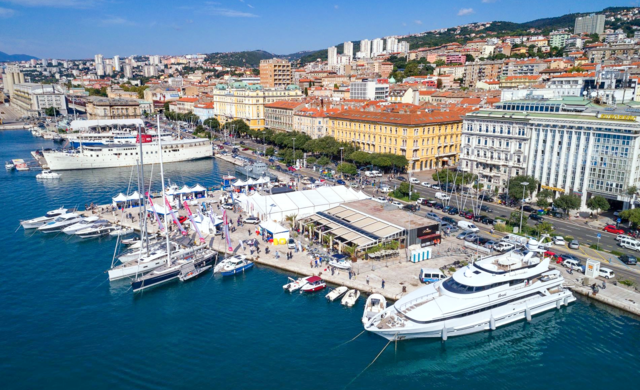
The grand city centre buildings once used for overnight stays by Austro-Hungarian businessmen and dignitaries are still there. In fact, some are still hotels. But, they’ve now been joined by a super range of ultra-modern options.
Hotels
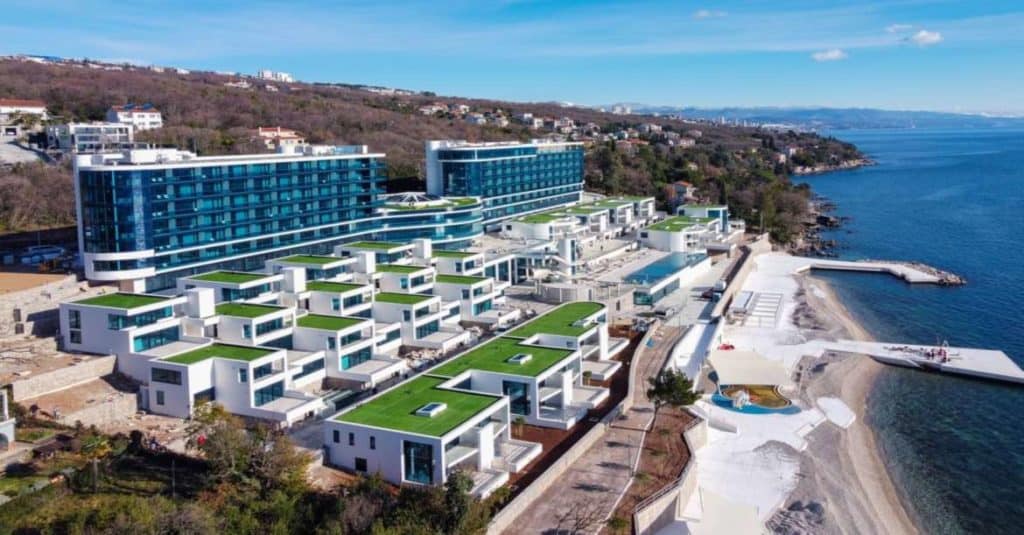
Opened in spring 2021, Hilton Rijeka Costabella Beach Resort & Spa is the newest. The main complex has 10 floors and 132 rooms. Moreover, the site also has 66 villas, six restaurant/bar/food outlets, a private beach, and one of the largest wellness facilities in the region
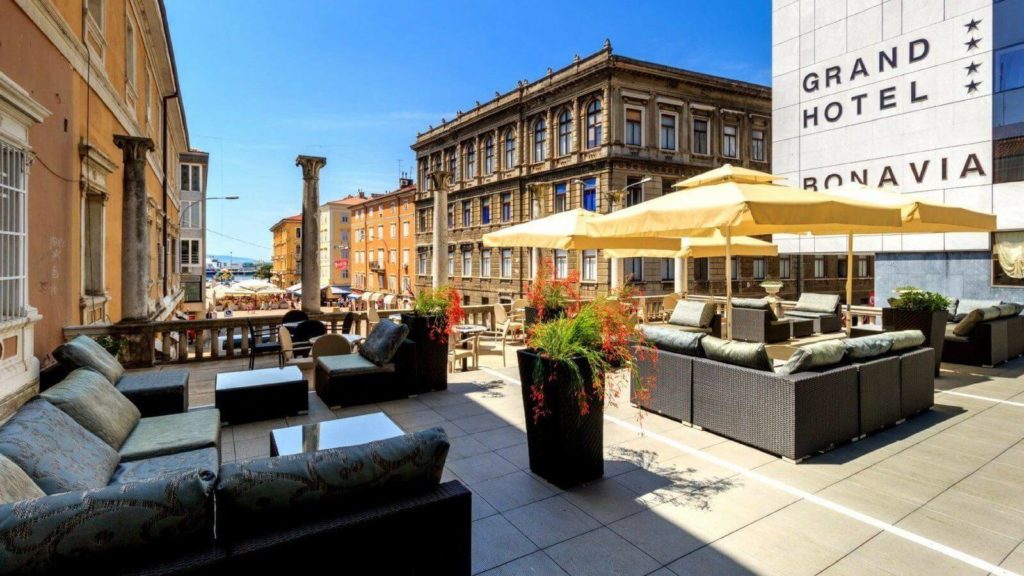
With balconies overlooking the bay, Hotel Jadran is also contemporary. So too are the refurbished four-star Hotel Bonavia Plava Laguna. And the three-star Hotel Neboder. Notably, the latter two are both centrally located.
Looking for something more traditional? The three-star Hotel Continental is one of the symbols of the city. It has been satisfying guests since 1888.
Hostels
Less than a decade ago, there was just one hostel in Rijeka. By comparison, these days you’re spoiled for choice. Check out the options on the usual sites. But, a bit of friendly advice. Rijeka rises sharply uphill as you travel north of the city centre. Subsequently, what may look close on a map when you book, might turn out to be a gruelling climb in summer heat. Or, you can just hop on a bus.
Apartments and villas
For seaside villas, you’re better looking further out from the city. The nearer you get to the Istrian peninsula or, the other way, towards Bakar, the better the options will be. However, Rijeka centre is now chock full of absolutely top-rate rooms and apartments to rent. Many are not much more expensive than a hostel Bargain! They’re perfect for exploring the city and surroundings by day. And, they’re a quick stumble home after enjoying Rijeka’s great nightlife. Check them out on the usual booking platforms.
Camping – Campsites near Rijeka
In the fast expansion of this city, a couple of things were omitted from the town planning. Parks, green and recreational areas were one. Therefore, places to camp have always been thin on the ground in Rijeka. However, you’ll find some super options as you turn onto the Istrian peninsula. Specifically, between Opatija and Mošćenička Draga. What’s more, these give you a great view of the city and are a relatively short ride away. There are more on Krk island, closer to Rijeka airport and one on the opposite side of the Bay of Bakar to Bakar Town itself.
Rijeka used to have one campsite, near the most westerly of Rijeka city beaches, the windsurfers favourite, Preluk. However, this closed 8 years ago and the site awaits repurposing.
Beaches in Rijeka
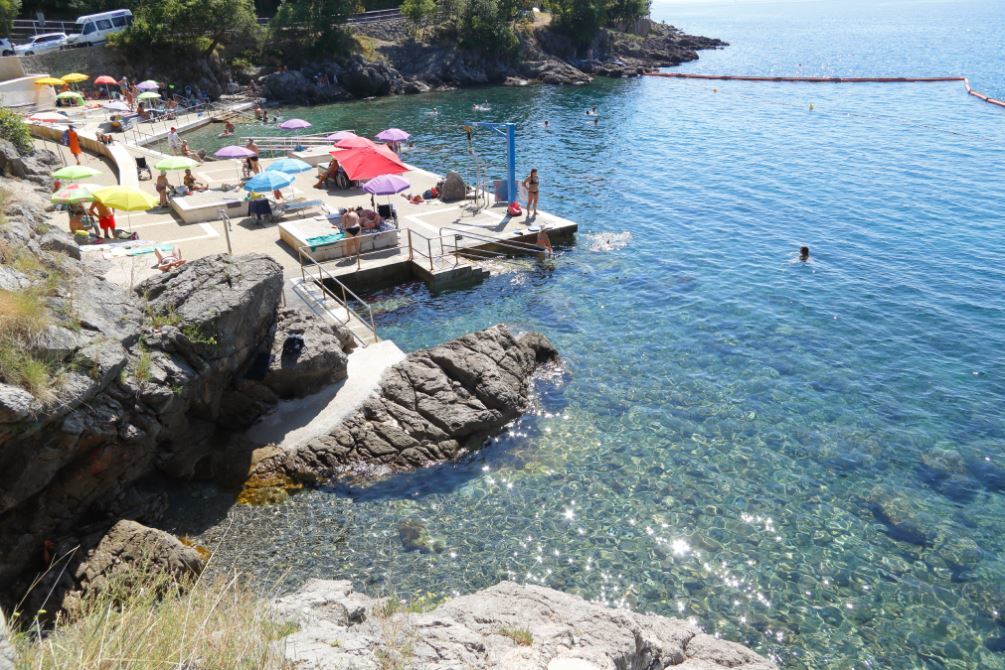
The city centre shore is no place to go for a swim and sunbathe. Don’t even try it. Basically, it’s a place to board a boat. However, you’re very close to some great beaches. Even if you can’t actually see them.
There are two ways Rijeka residents approach the beach. Either you go local for a quick dip, or you make a day of it. Both to the immediate east and west of the centre are good beaches. Lying within easy walk of city neighbourhoods and suburbs, locals drop by to cool off after work. Some have water sports. At others, you can take your dog. What’s more, many have showers. You can walk from the centre to the nearest beaches on the east. However, those to the west are best visited by bus. They’re only a couple of minutes ride.
In general, the further from the city you go, the more likely you are to find peaceful seclusion. Looking to escape the buzz and bustle of the city? Stay on the bus a bit longer, or take a car.
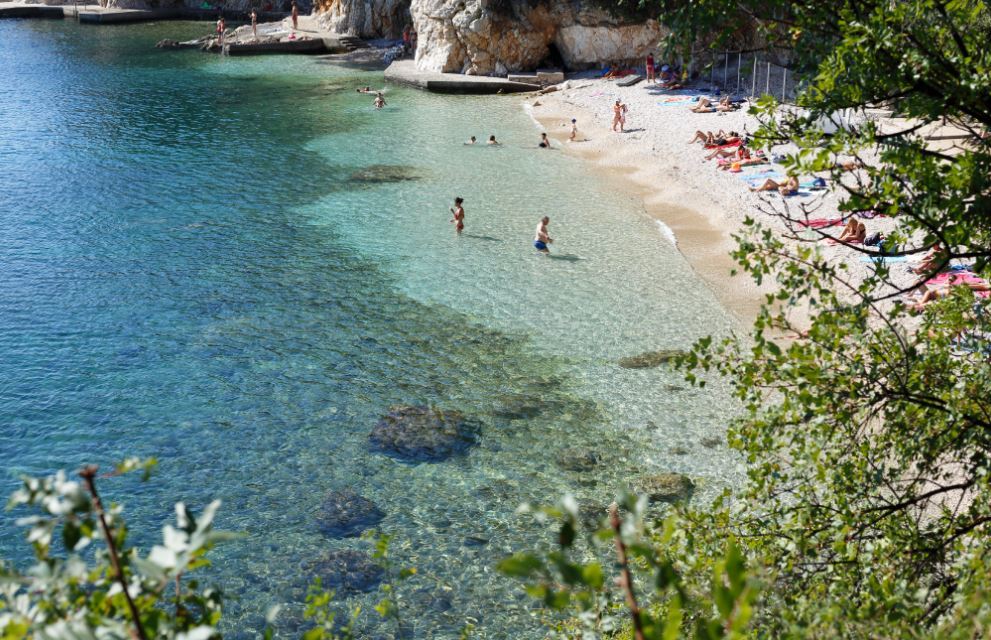
Beaches east of the city centre
To the east of the city centre there are four beaches – Brajdica, Sablićevo, Glavanovo and Grčevo. First of all is Brajdica. Above all, this is a dog beach. By all means, swim there if you like. But, not many do. By comparison, Sablićevo is better option for a quick bolt from the city and into the sea. In fact, it’d probably take you less than 15 minutes to get there. After that you have Glavanovo, which is kid-friendly, with shallow seas and shading trees. Finally there’s Grčevo. Moreover, these final three all have showers. facilities.
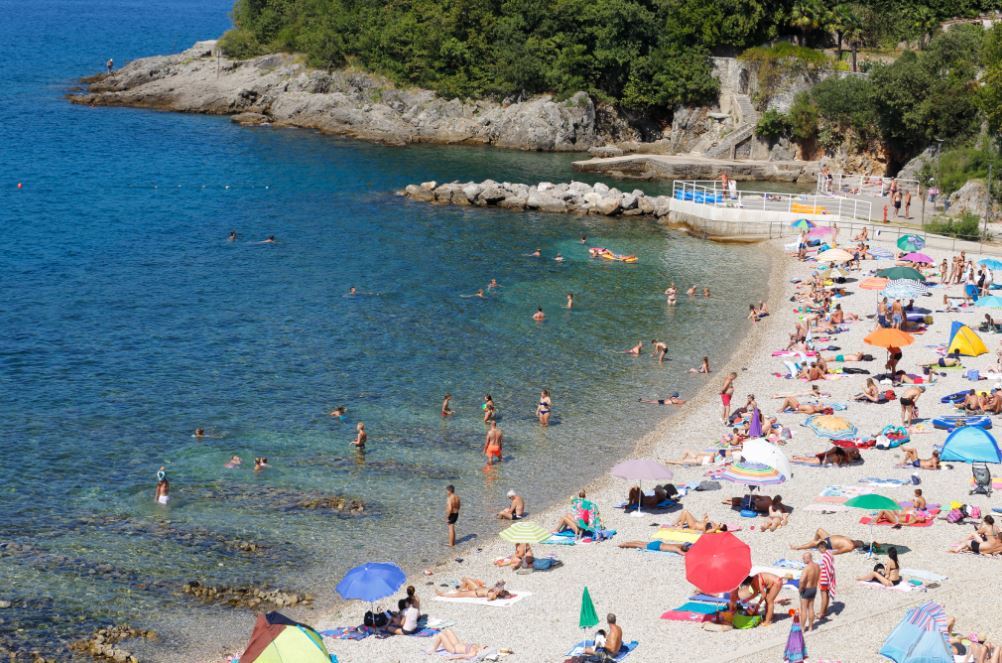
Beaches west of the city centre
The shore to the west of the city extends in a more-or-less straight and uninterrupted line for 10 km. Subsequently, there are many more beaches here. Furthermore, a new pedestrianised shoreline path makes this a lovely walk. Alternatively, just hop on a bus and jump off at one you like the look of.
Igralište is the nearest (although there’s another dog beach before it, at Kantrida). Notably, Igralište has a volleyball court and, in summer, a toboggan and food options. Moreover, the party extends into nighttime hours here. In the second place westwards from the city is Ploče. Without a doubt, it’s a big deal of a beach. It’s got a Blue Flag for its clear waters, summertime lifeguards, volleyball court and swimming pools.
Next up is the secret cove of Razbojna. Undeniably, this beach is small. Furthermore, the positives of the seclusion hold certain negatives. It’s shaded from the sun until around midday. And, the sun disappears soon in the late afternoon too. Thereafter you reach the tree-lined Bivio beach. Also it has a toboggan and sits very close to the Hilton Rijeka Costabella Beach Resort & Spa.
Above all, the secluded Kostanj Bay should be noted for the way it has been sculpted to accommodate the disabled. Indeed, they’ve done brilliantly, with a smooth, concrete walkway running right into the sea. Furthermore, facilities such as showers and toilets are also fitted to suit. It’s Blue Flag beach too. Immediately before the coast turns into the Istrian peninsula, is Preluk beach. Significantly, this place catches the wind. Windsurfers descend on the bay in the early mornings to make the most of the meteorological phenomenon. Small boats, swimmers and sunbathers enjoy it too.
Weather
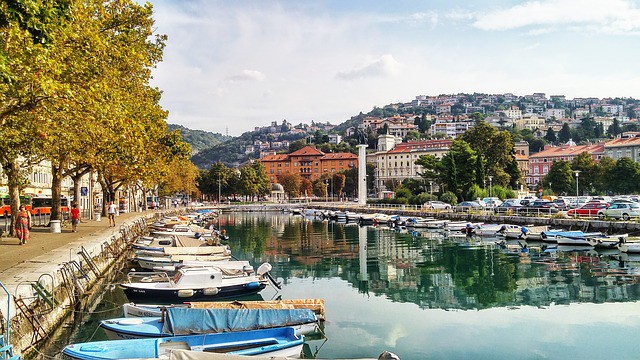
It rains in Rijeka. Certainly, it’s the rainiest city in Croatia. In fact, it has on average more annual rainfall than Manchester, UK. Not to mention that, in England, we call Manchester ‘the rainy city.’
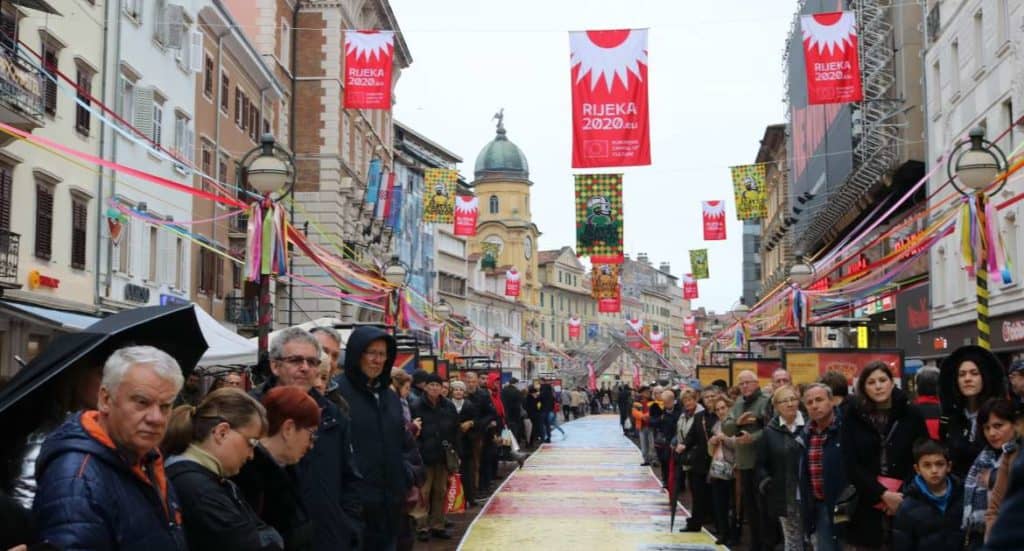
Here, the rainfall comes from a topography which, like the city itself, is unique. Basically, the Dinaric Alps run parallel to the shore down much of the Croatia coast. However, nowhere are they nearer to the sea than at Rijeka. Indeed, the rise of ground from the Adriatic to the mountains behind is so sheer that many city residents live on high, in tower blocks overlooking their own city. Subsequently, when clouds travel in from the expanse of sea, they hit the mountains just behind Rijeka and drop their loads on the city. In Manchester, we optimistically say “Great weather for trees!”
But, the rain in Rijeka is not like the rain in Manchester. Without doubt, the rain in Manchester is worse. While Manchester rain often stubbornly remains in the air, hanging around to slowly drench every fibre you wear, the Kvarner rain is not like that. Rather, Rijeka rain is more like a short, sharp shock. You can be sunbathing on the beach in the morning, only for doom-filled clouds to suddenly roll in from nowhere. The violence of their release is often best appreciated indoors. But, give it an hour or so and surprisingly you can be back on the sun lounger. That’s just how it goes with Rijeka rain. Here’s how things look now and for the rest of the week.
var css_file=document.createElement(“link”); var widgetUrl = location.href; css_file.setAttribute(“rel”,”stylesheet”); css_file.setAttribute(“type”,”text/css”); css_file.setAttribute(“href”,’https://s.bookcdn.com/css/w/booked-wzs-widget-275.css?v=0.0.1′); document.getElementsByTagName(“head”)[0].appendChild(css_file); function setWidgetData(data) { if(typeof(data) != ‘undefined’ && data.results.length > 0) { for(var i = 0; i < data.results.length; ++i) { var objMainBlock = document.getElementById('m-booked-weather-bl250-83928'); if(objMainBlock !== null) { var copyBlock = document.getElementById('m-bookew-weather-copy-'+data.results[i].widget_type); objMainBlock.innerHTML = data.results[i].html_code; if(copyBlock !== null) objMainBlock.appendChild(copyBlock); } } } else { alert('data=undefined||data.results is empty'); } } var widgetSrc = "https://widgets.booked.net/weather/info?action=get_weather_info;ver=6;cityID=15151;type=3;scode=124;ltid=3457;domid=w209;anc_id=42357;countday=undefined;cmetric=1;wlangID=1;color=137AE9;wwidth=430;header_color=ffffff;text_color=333333;link_color=08488D;border_form=1;footer_color=ffffff;footer_text_color=333333;transparent=0;v=0.0.1";widgetSrc += ';ref=' + widgetUrl;widgetSrc += ';wstrackId=343132';var weatherBookedScript = document.createElement("script"); weatherBookedScript.setAttribute("type", "text/javascript"); weatherBookedScript.src = widgetSrc; document.body.appendChild(weatherBookedScript)
Kisha umbrellas
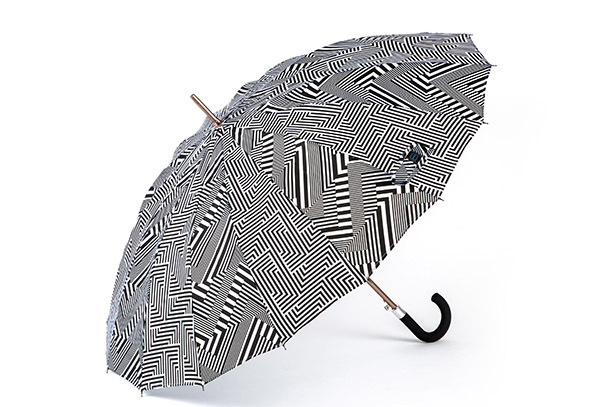
In any other Croatian city, the rainfall here would produce double the hours of moaning about it. Perhaps it’s a strong indicator of just how different this city is that it should instead catalyse an international business. Not only do Rijeka’s Kisha umbrellas come in fabulous male and female designs, but also they include a handy locator. You need never lose your brolly again. What’s more, they make an excellent gift (perhaps to someone from Manchester?)
Is Rijeka Worth Visiting? What to do in Rijeka
So, is Rijeka worth visiting? Yes, it is. Of course, it all depends on what you actually like. But, Rijeka is such a weird combination of seaside destination and thrilling big city, you can find great things to do in Rijeka whatever your tastes.
Music
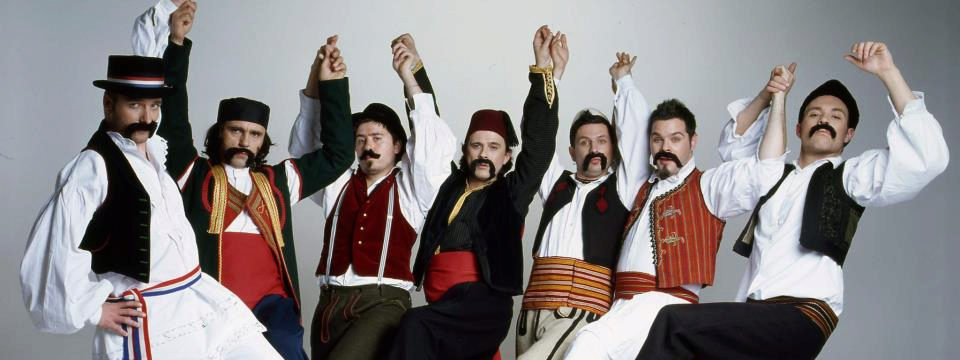
Rijeka music heritage
This city is famous for its music. Some of Europe’s great classical musicians, orchestras and opera stars have trodden the stage of the Croatian National Theatre Ivan Zajc. They still do. But, within more contemporary sounds, Rijeka’s famed musical heritage stems back to the days of punk and post-punk. In fact, several key bands of the era came from Rijeka. Moreover, some longstanding legends still perform to this day. Specifically, new wave electropop duo Denis & Denis and rock provocateurs Let3.
Music venues and events
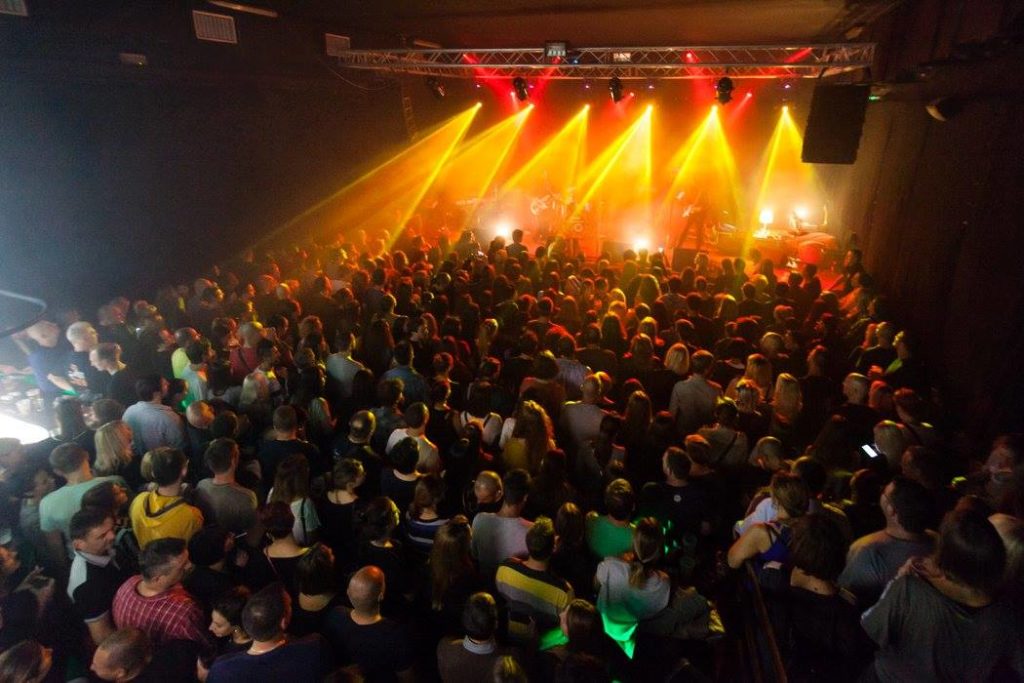
However, music in the city is far from a thing of the past. Rijeka has several great music venues, like Palach and Pogon Kulture. Here you can catch the best of Croatia’s rock and leftfield music stars and visiting international guests. Keep a look out for the city-wide, week-long Impulse Festival. It brings a well-curated mix of regional and global talent each April.
However, music in the city is not restrained within regulars clubs and concert halls. Indeed, Rijeka bucks the trend in many ways. Music here often spills out onto the streets. You might see performances at Trsat castle in the summer. Large, former industrial buildings have been put to exciting new uses here, such as the former torpedo factory and Exportdrvo. Look out for pop-up techno, rave and alternative music events in these.
Rijeka Carnival
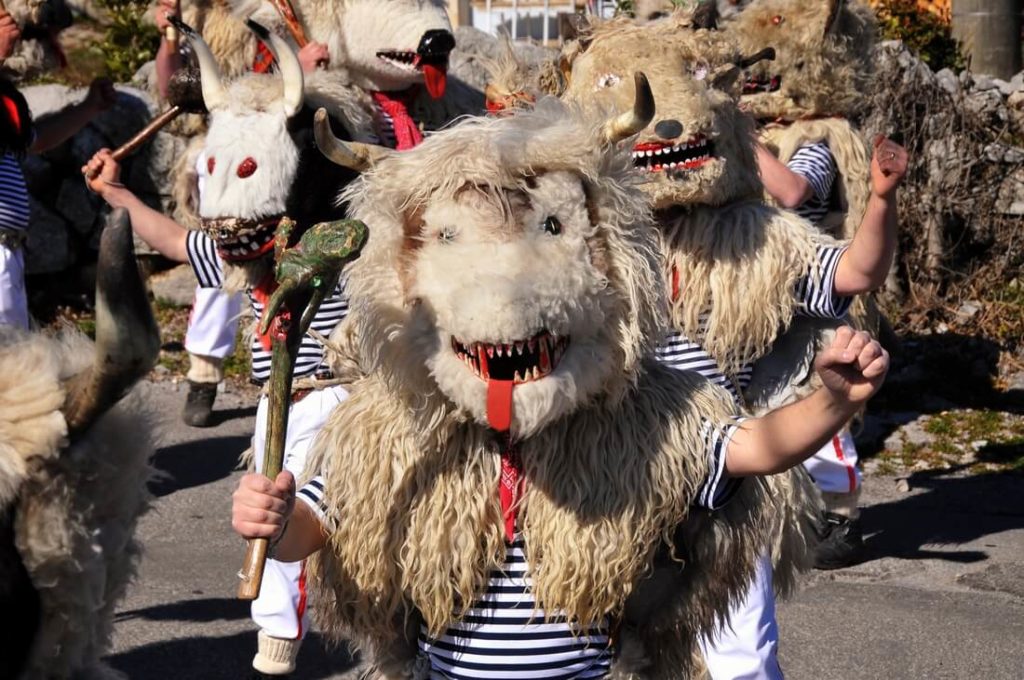
On 17 January, the Feast of Saint Anthony the Great in Croatia, in Halubje, Kvarner, near Rijeka, carnival games, festivities and music fills the streets. The town’s Halubajski Zvončari are bellringers made up with elaborate masks and rustic costumes. The sounding of horns marks the official commencement of carnival season and of the Zvončari marching. Over subsequent days, they will march, accompanied by music, through villages in the region, eventually descending into Rijeka on carnival day. It’s an ancient tradition, recorded in written records in 1860. And, these Zvončari are responsible for the revival of Croatia’s largest carnival.
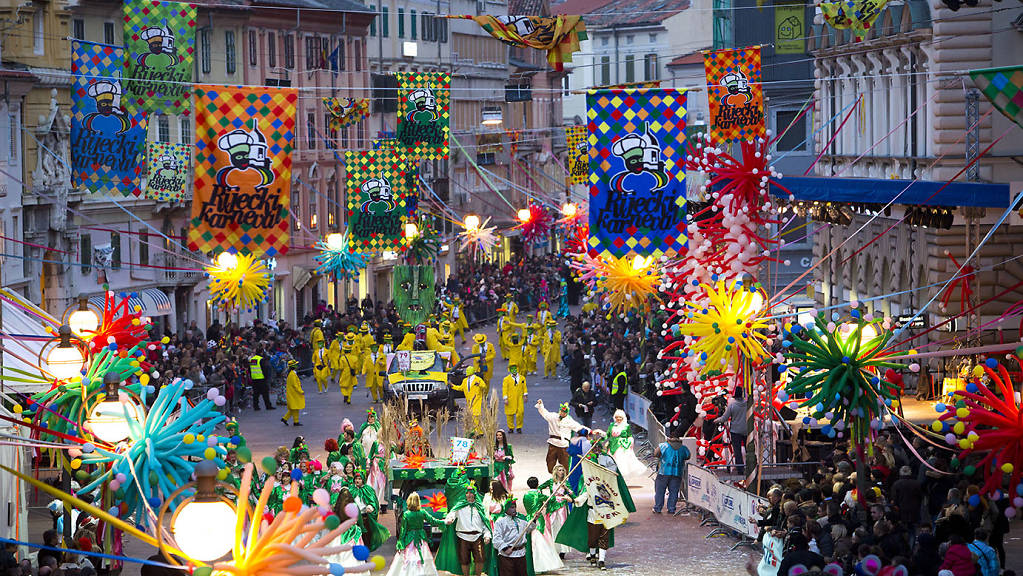
Thousands take part. Groups in costume, some have practised choreographed dance moves for weeks in preparation. Others ride on trucks with huge soundsystems. Every colour imaginable can be seen in the march. And it seems as though every Kvarner school kid and student is part of the parade. A greater number still line the route as it snakes through the city centre. It takes hours. Afterwards, the revelry doesn’t stop until sunrise.
Advent: Christmas in Rijeka
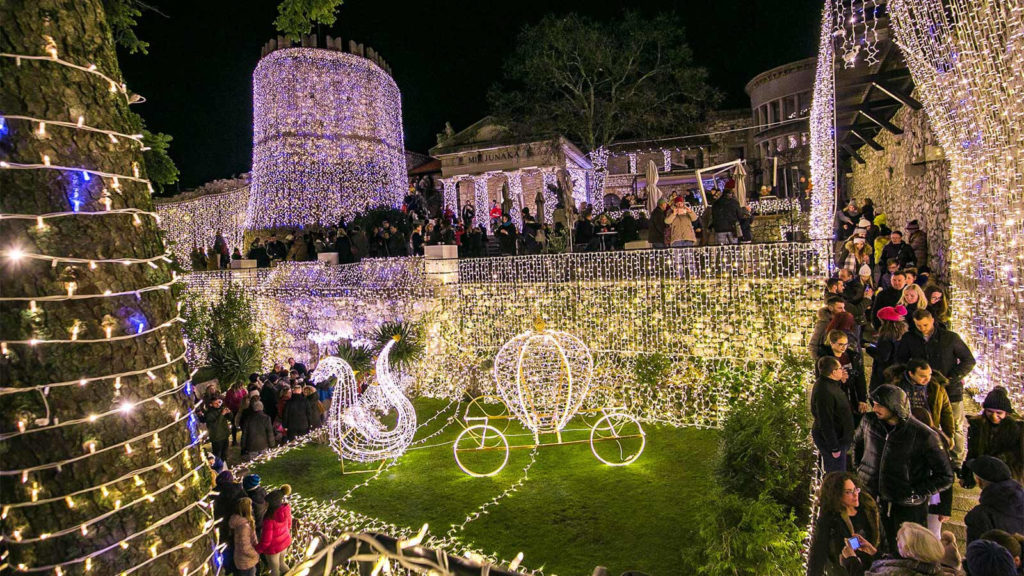
Undoubtedly, the Christmas markets in Zagreb are Croatia’s most famous. However, Christmas in Kvarner is taking huge strides to become the next best-known. The decorative lights placed in and around Rijeka, its Trsat castle and in nearby Opatija is simply incredible. They’ll take your breath away. Who’s says seaside visits are only for the summertime?
Street art
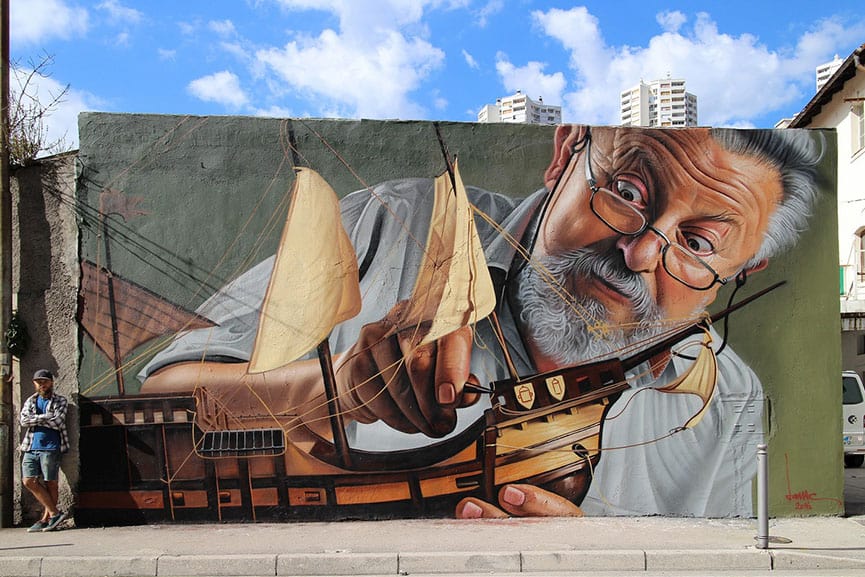
Street art and graffiti have been a vivid addition to the Rijeka cityscape for many years, thanks in no small part to local mainstays like Vladimir Tomić aka Mosk. Indeed, one of the earliest examples ‘Punk Paraf’ stems all the way back to the post-punk period. However, over recent years, the city has fully embraced this form of public art. Some of the most famous names of Croatia’s street art scene have since been invited to come and leave their mark. Additionally, they’re been joined by players from the world stage. Take a look around and see what you can find.
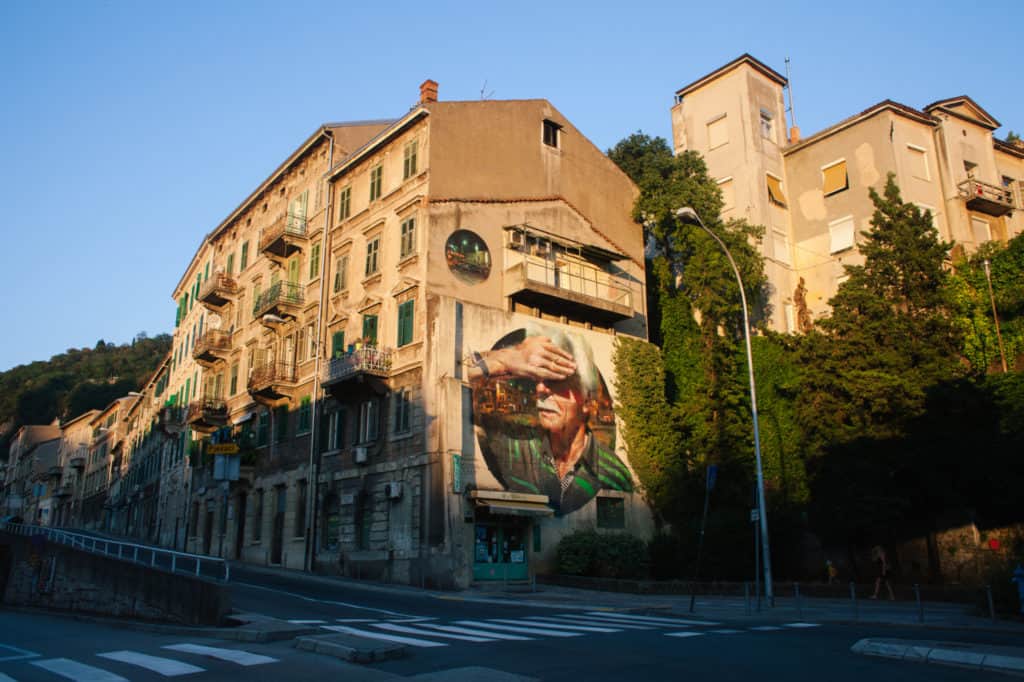
City centre, Old Town, Korzo, Trsat castle
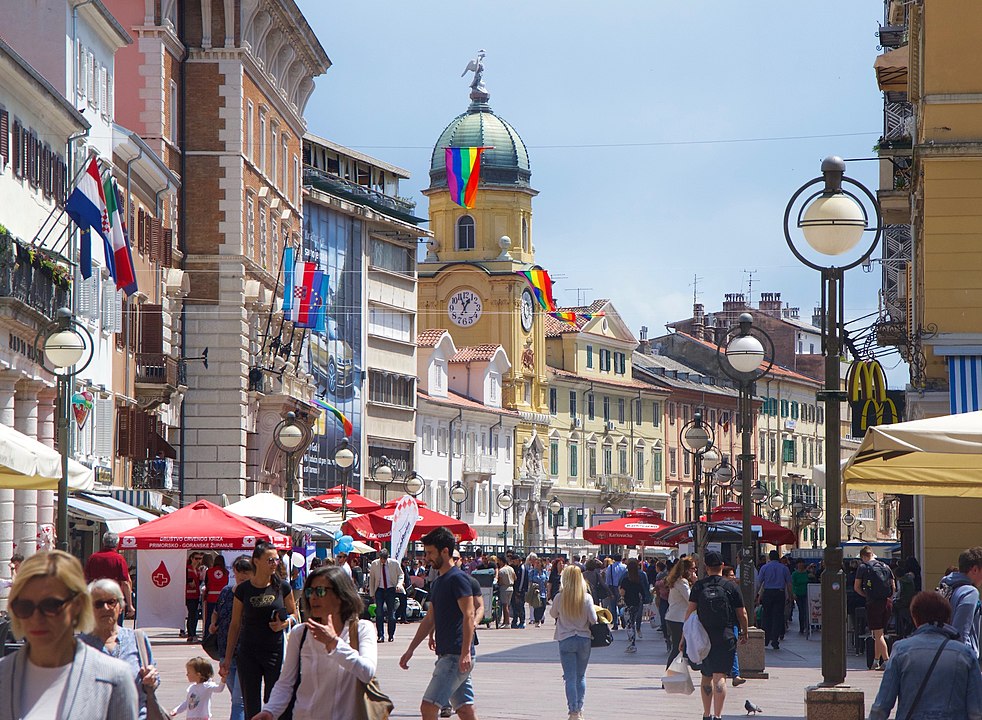
Unlike many Croatian cities, Rijeka doesn’t so much have a clearly identifiable old town. The earliest parts of Rijeka bleed into the modern city centre. Subsequently, it can be a surprising and lovely stroll.
One minute you’ll be walking down the huge, pedestrianised street Korzo through the centre, tempted by fast food, fashion stores, restaurants and cafe terraces. But, turn off to one side and you can be passing ornate Austro-Hungarian palaces, sea-view brasseries and the beautiful garden before the spectacular National Theatre. Alternatively, turn the other way, nearer the end, or perhaps through the arch beneath the city clock tower and you’re somewhere different entirely. Hidden squares, passageways, places of worship or well-worn narrow, winding streets are revealed.
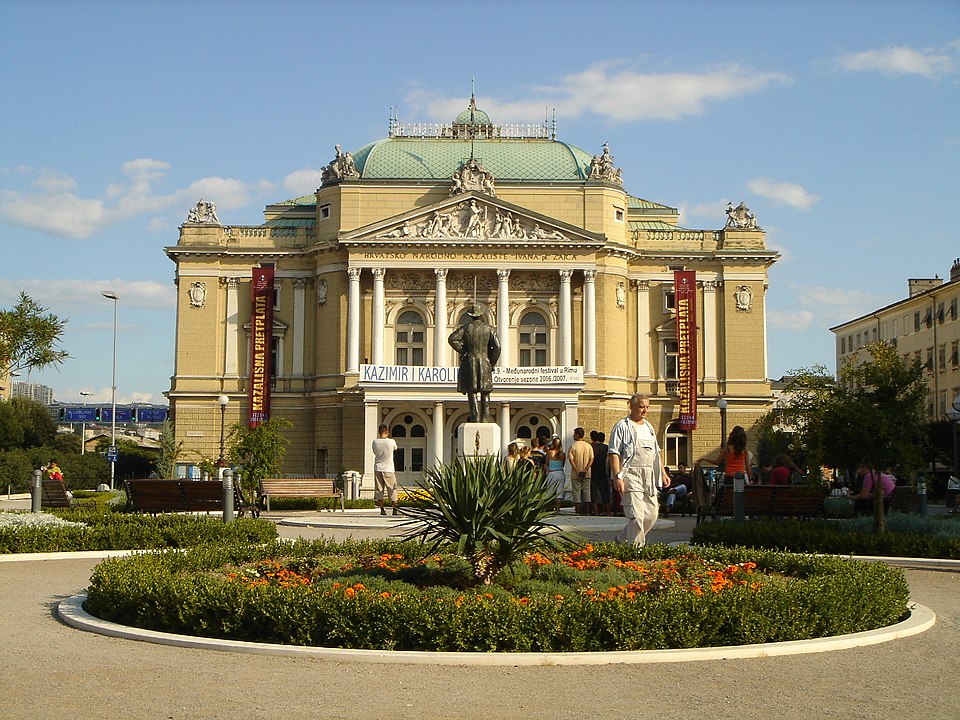
1970s
Central Rijeka is a wonderful place in which to briefly get lost. Don’t worry, it’s not that big. You’ll soon get your bearings. But, if you’re going to explore, try not to do it on a weekend. Or, at least go before midday on Saturday. Why? Well, not content with having the whole of the next day (Sunday) off, most stores in central Rijeka shut up shop early on Saturday afternoon. Yes, we realise the weekend is when everyone else is off work and it’s the perfect time to go shopping. Rijeka sees things differently. This is how much of Europe must have once looked. Maybe in the 1970s. When your grandparents were teenagers. Suck it up.
Trsat castle
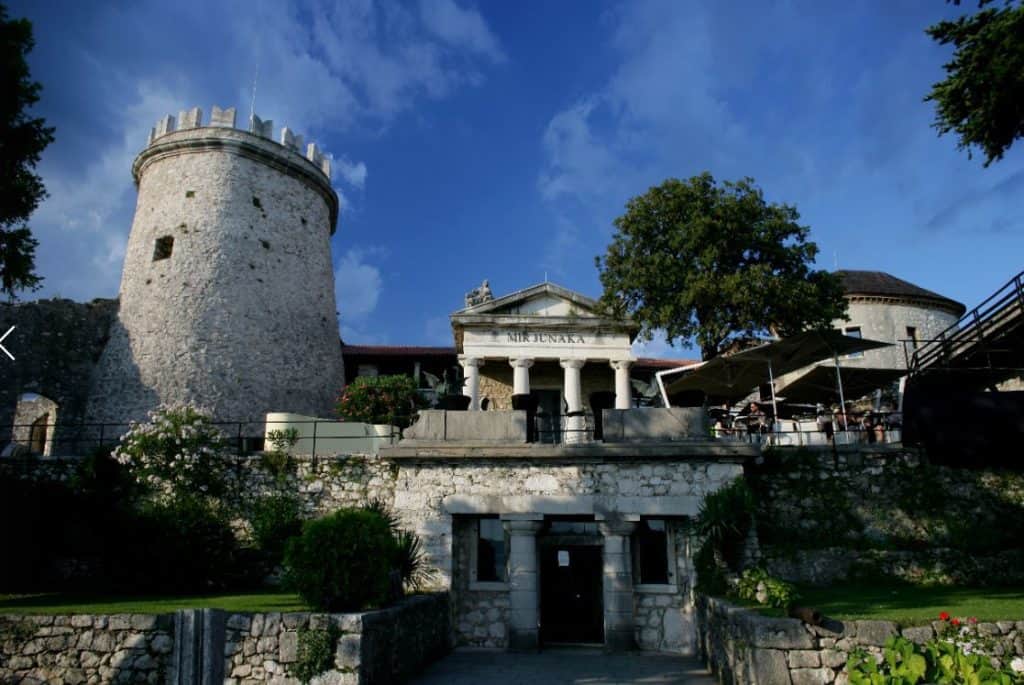
Rijeka rises sharply from sea-level into nearby heights. Indeed, the cityscape vista is superb from the balconies of residential tower blocks in overlooking neighbourhoods. But, the best view of Rijeka is from Trsat castle.
View over the Rječina valley
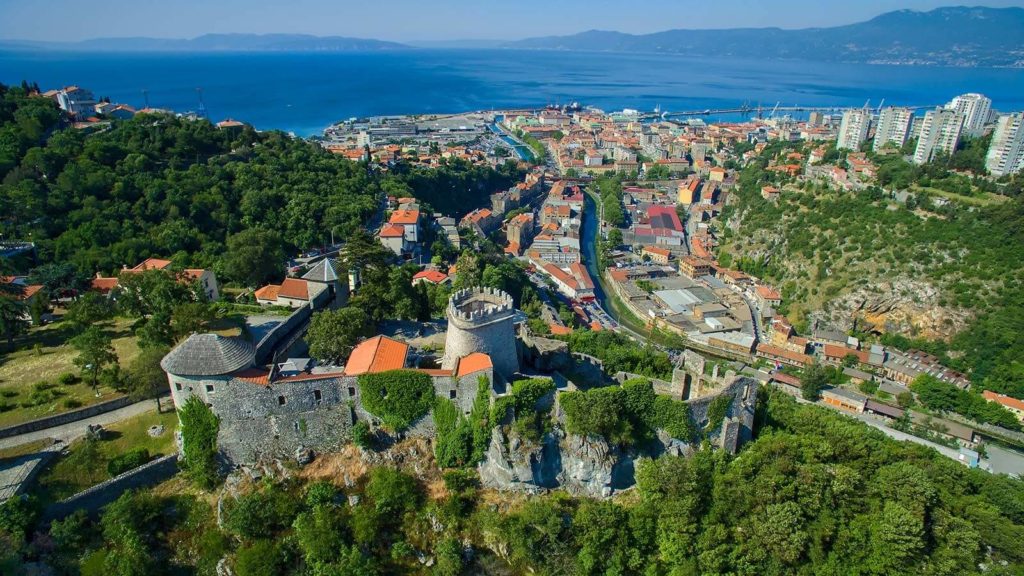
The Rječina valley separates you from the competing high rises. immediately below you, the river itself scores a path through a varied landscape of industry, old town and modern city centre. Thereafter, it flows into the vast Kvarner Bay. On the horizon, the islands of Cres and Krk. Breathtaking.
Sitting 150 meters above Rijeka, it’s thought that Trsat castle lies on top of an earlier Illyrian and Roman fortress. Undeniably, Trsat castle is today one of the most popular tourist attractions in Rijeka. Moreover, it is one of the top 20 castles in Croatia. And, it’s one of very few on the coast. Its grounds contain a restaurant. And, the whole surrounding neighbourhood (also called Trsat) is rather charming, with a couple of old churches to explore.

Museums: Heritage, nature, history, culture, art
Museum of Modern and Contemporary Art Rijeka
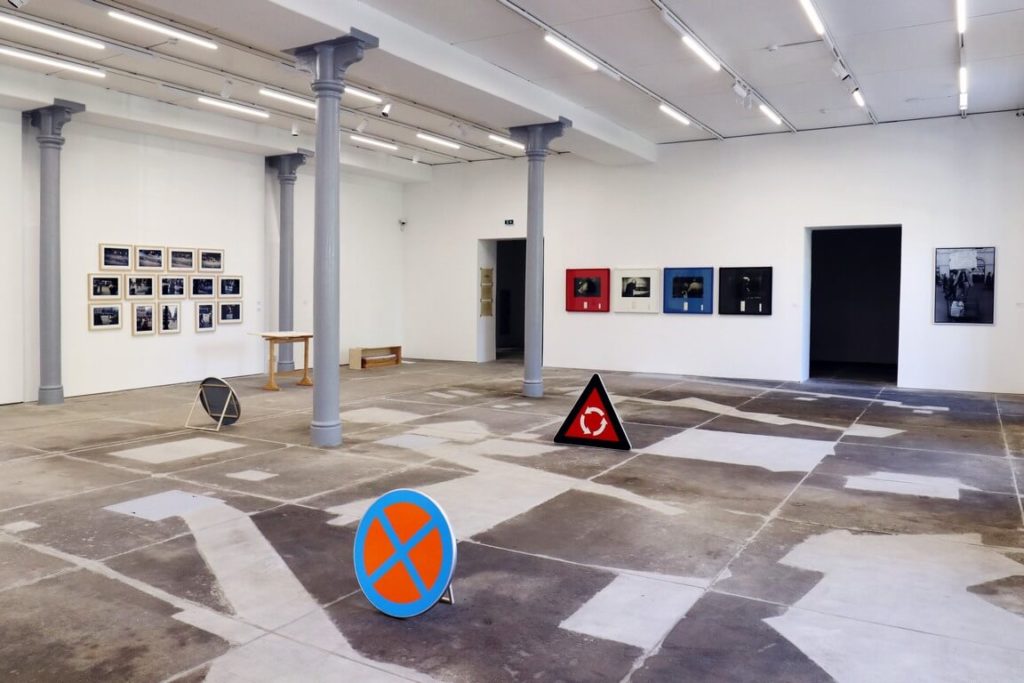
Second only to the one in Croatia capital Zagreb, the Museum of Modern and Contemporary Art Rijeka is the biggest and best museum of its kind in the country. Moreover, a relatively recent move to a much larger, former-industrial complex has paid off. Specifically, the expanded floor space allows the museum to show off more of its vast collection. It does so in rotation, with guest exhibitions appearing alongside.
Rijeka City Museum
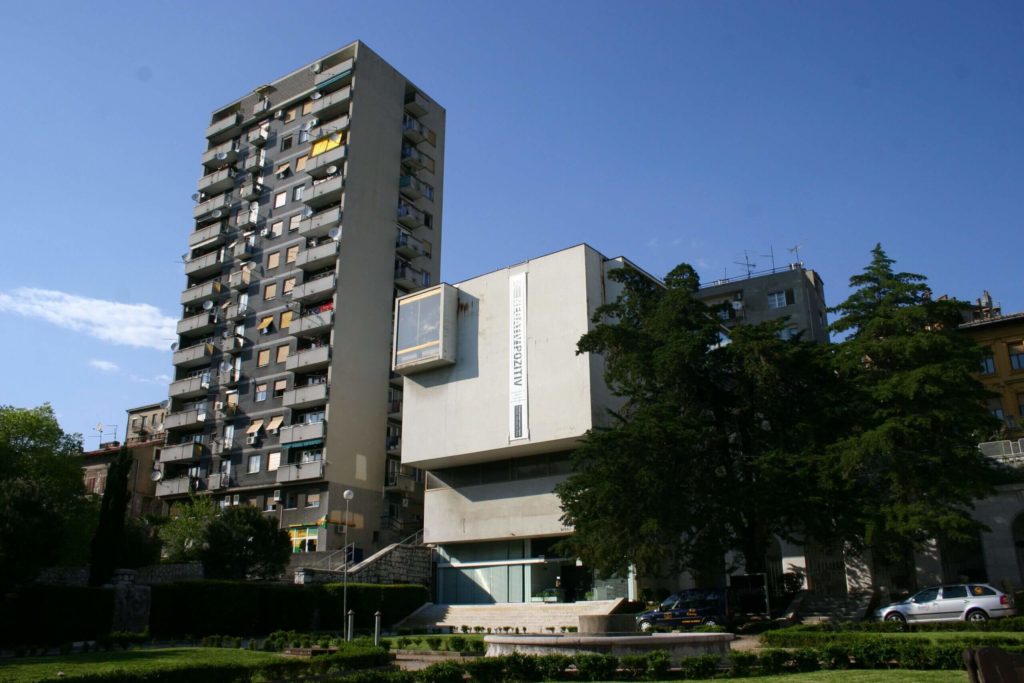
They like to keep things fresh at Rijeka City Museum. Subsequently, it devotes much of its three floors to fascinating temporary exhibitions. Chiefly, they are concerned with city history. And, what a history it’s had! Not only will you learn about Rijeka’s maritime dominance of the region and industrial innovation, but also its time under Roman, Venetian, French, Hungarian, Italian, Austro-Hungarian and Yugoslavian rule.
Natural History Museum Rijeka

Sharks and rays suspended in air create thrilling memories for curious family members at the Natural History Museum Rijeka. But, not only does the collection cover Kvarner Bay and the Adriatic, there’s a wealth to discover from inland regions and Istria too.
Rijeka Maritime and History Museum of the Croatian Coast
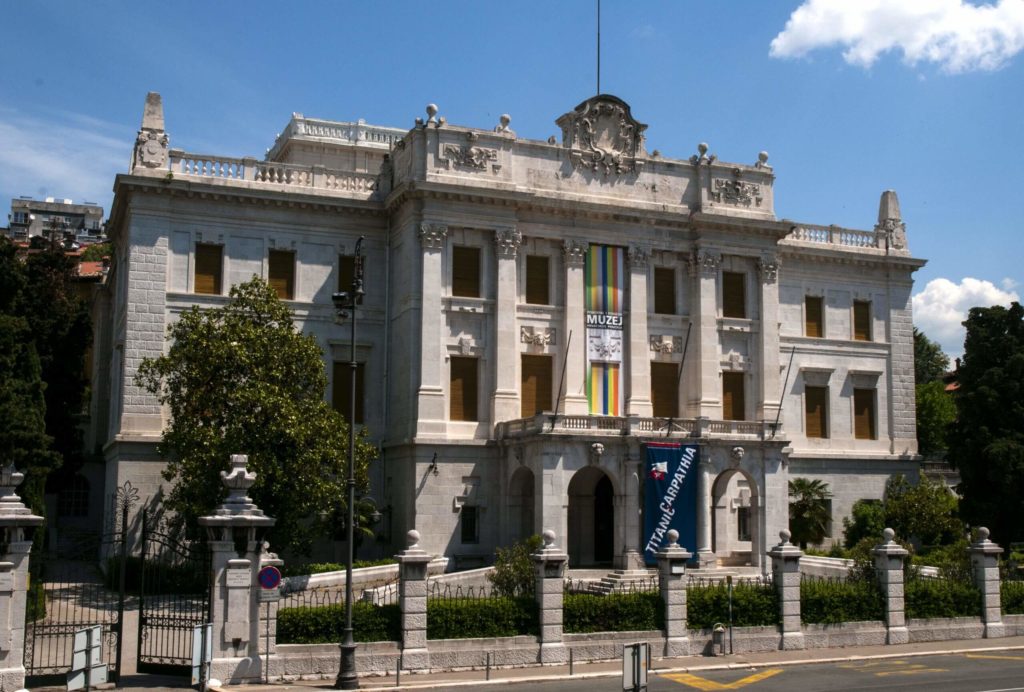
One of the city’s most beautiful 19th century Austro-Hungarian palaces houses Rijeka Maritime and History Museum of the Croatian Coast. As a matter of fact, exhibitions here are as traditional as the host building. Specifically, you’ll find fine art here, also archaeological, ethnographic and cultural, and maritime departments.
Peek & Poke
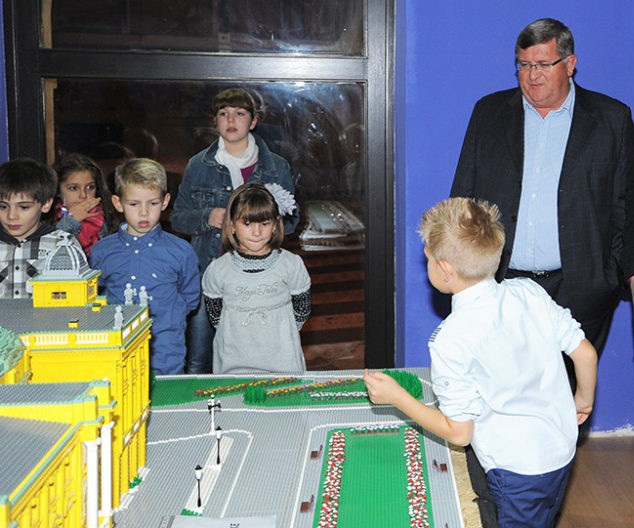
Partially an enthusiasts club, the informal Peek & Poke is dedicated to childhood memories and vintage computers. Want to see how computer gaming looked long before you were born, in a time when shops of major cities only worked half a day during weekends? This is the place.
Hiking, walking, skiing, nature: Učka Nature Park, Risnjak National Park, Platak
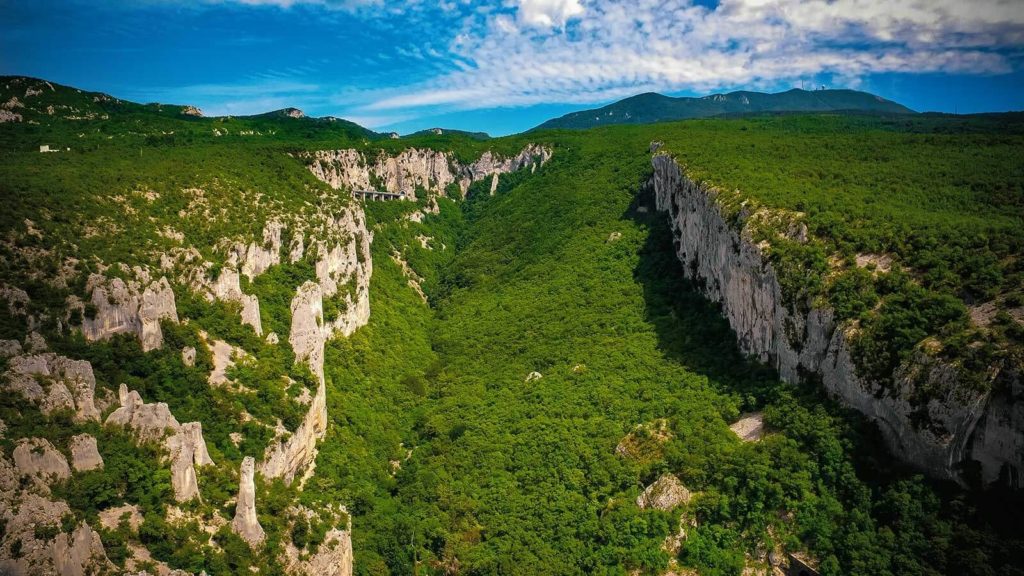
Rijeka’s wild options hold an even greater contrast the further from the city centre you travel. For example, did you know you can go skiing here? Not only is Platak just 30 minutes from the beach, but also it’s one of the best places in Croatia to ski. Both by day and at night!
An epic mountain landscape and dense forest create unforgettable views in Risnjak National Park. It’s less than an hour’s drive north of Rijeka. The area surrounding Učka mountain, an hour’s drive to the west of Rijeka, is also protected. However, more often than not, it the high peak of the mountain in Učka Nature Park that visitors most come to see. The view it gifts is epic, a spectacular vista of mountains, beach, forest and sea. And, you can take your car all the way to the top. Moreover, for active types, both parks are great year-round for walking and hiking.
Where to eat? Rijeka restaurants
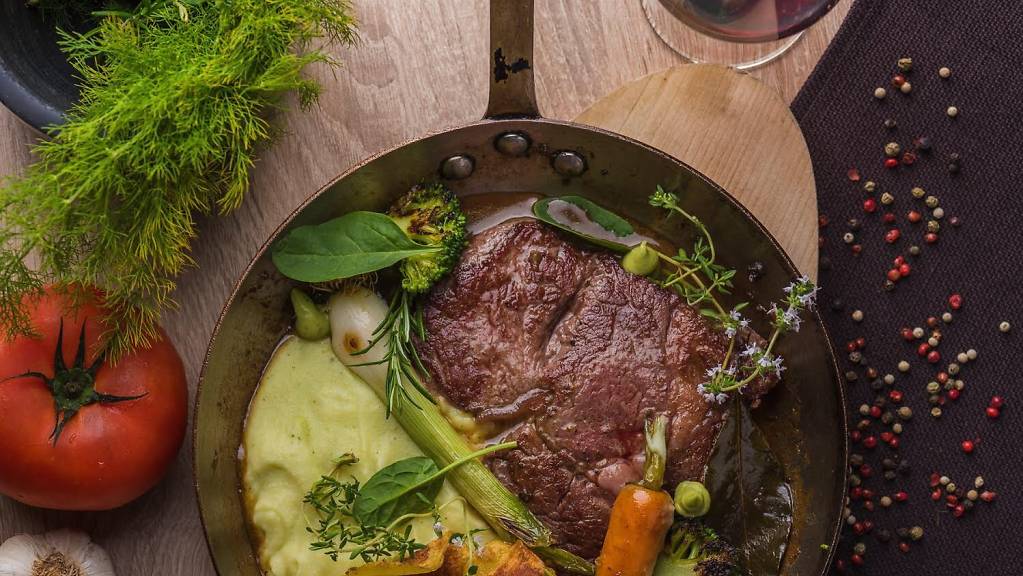
From fast food and authentic pizza to fine dining and brilliant, informal brasseries, Rijeka really has got the lot. And, don’t be fooled by the city’s non-Mediterranean feel. This is as good a place to eat seafood as anywhere on the Croatian coast. In fact, Rijeka is famous for fresh oysters.

Want to eat fresh seafood out on a terrace? Try Municipium, Konoba na Kantunu, Bistro La Rose or Placa 51. Pizza for lunch? Head to O’Hara. Craving a burger? Submarine’s your spot. Fancy hearty and traditional food? Tarsa, Bistro Mornar and Trsatika are good options, Primorska Konoba similar but maybe a notch up in fanciness.
Where to drink? Bars and cafes
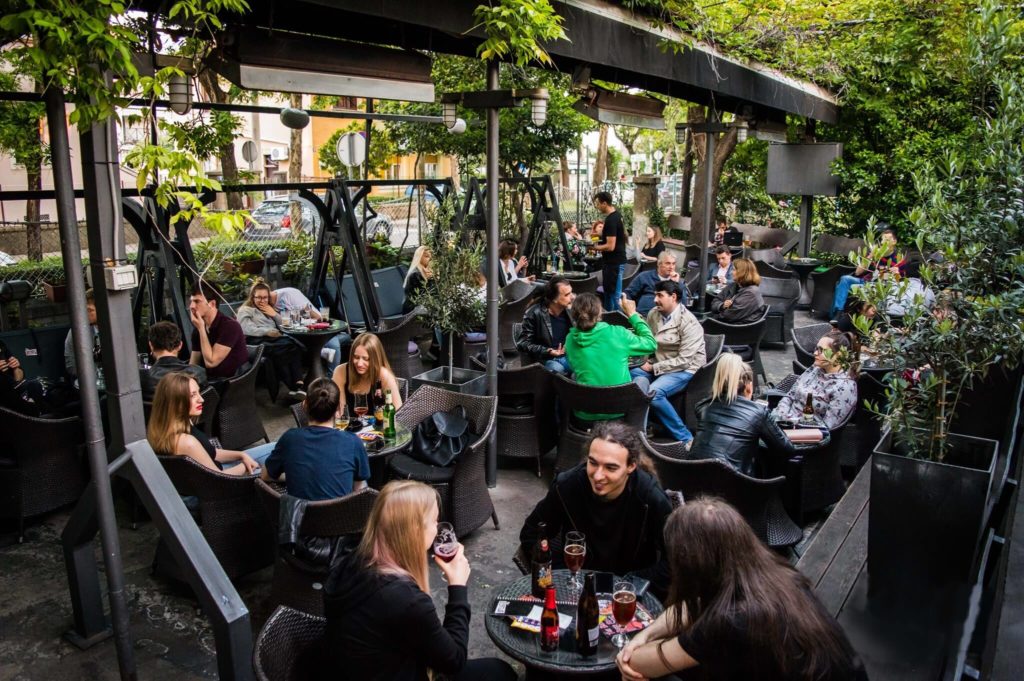
There really are too many brilliant bars in Rijeka to name each one. Make friends with a local to find them all. Be prepared to commit yourself to several nights drinking! Serious about your craft beer? Try King’s Caffe, Celtic Caffe Bard or Beertija. Fancy a cocktail? Go to Three Monkeys. Want a late night? Rakhia bar is a lively spot, specialising in the national drink. On weekends, DJs and live acts sometimes help a young, hip crowd stay up late at Tunel (yes, it’s in a tunnel).
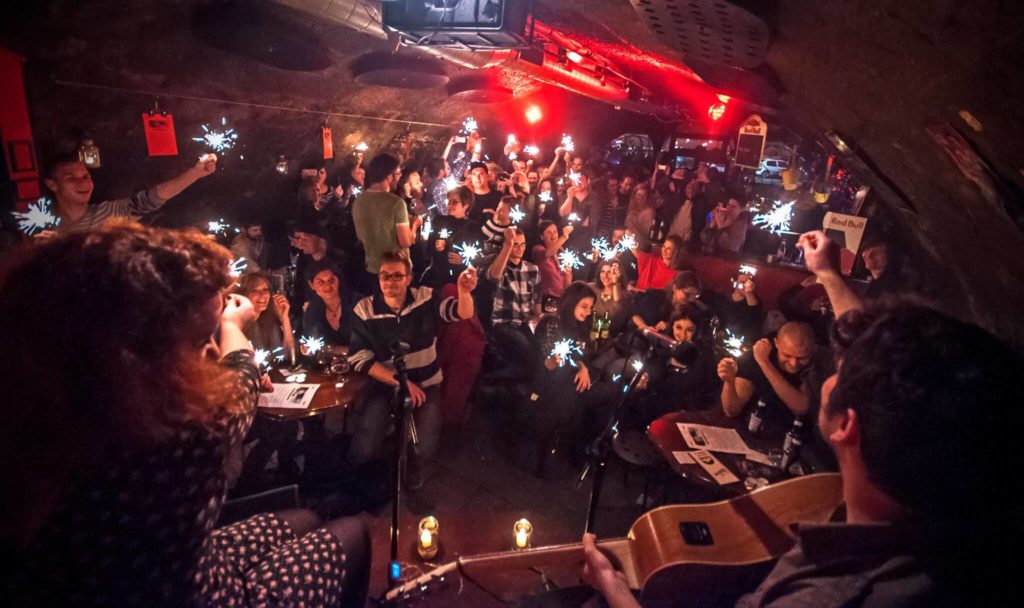
How to get to Rijeka: Port, Cruise, Ferry, Flights, Airport, Fly, Train, Bus
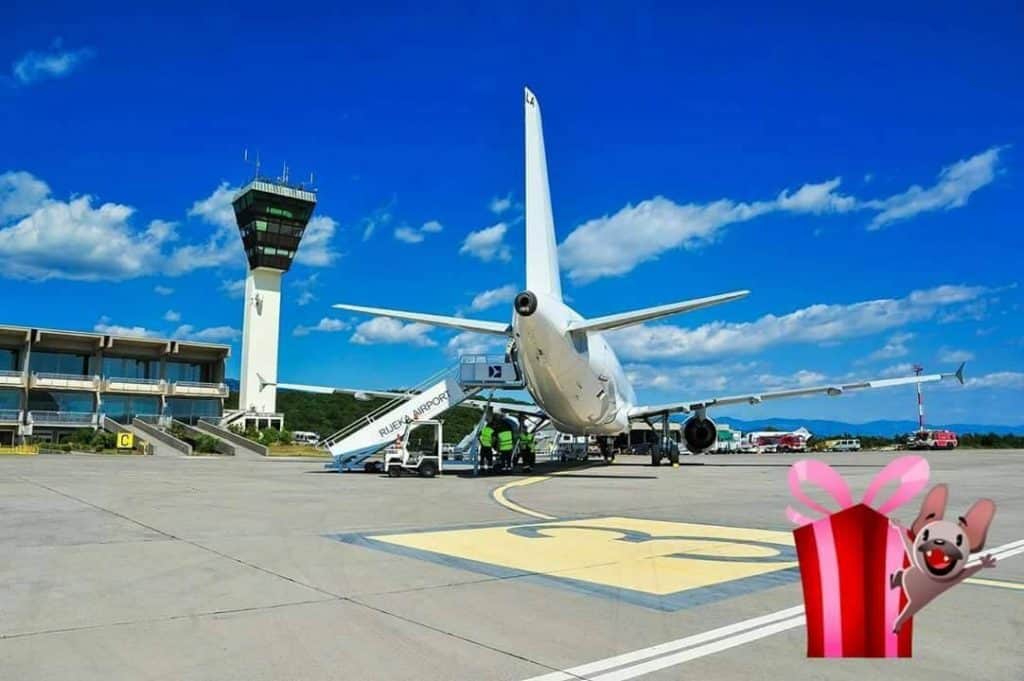
Behind the capital, Zagreb, Rijeka must be the best-connected city in Croatia. It is a major transport hub. And, it always was.
Croatia’s Second Railway
Rijeka was the second place in Croatia to have a passenger rail connection. It brought the upper echelons of society direct from the heart of the Austro-Hungarian to the Kvarner coast. It was used by those who did business through the port. And, it serviced Croatia’s first international tourism. Over 100 years ago, those who could afford such extravagances departed the train in Rijeka. Thereafter, a horse-drawn tram took them from the industrial city to enjoy the pleasant year-round climes and wellness reputation of nearby Opatija.
Indeed, those links remain today. Albeit in a much more modern form. On Kvarner’s integrated public transport system, you can travel by local bus or train between Bakar, Rijeka and through Opatija, right up into the hinterland and the border with Slovenia. In fact, you can do it all on just one ticket. Read more about it here.
Flights to Rijeka, fly to Rijeka airport
The Kvarner capital and indeed the whole of Istria and northern Croatia is serviced by the city airport. However, it’s deceptively titled. Flights to Rijeka airport actually land on nearby island Krk. But, it’s super close and connected to the mainland by a wide, modern bridge. You can here read everything you need to know about flights to Rijeka and the airport itself.
Rijeka Port: Ferries, boats and cruise
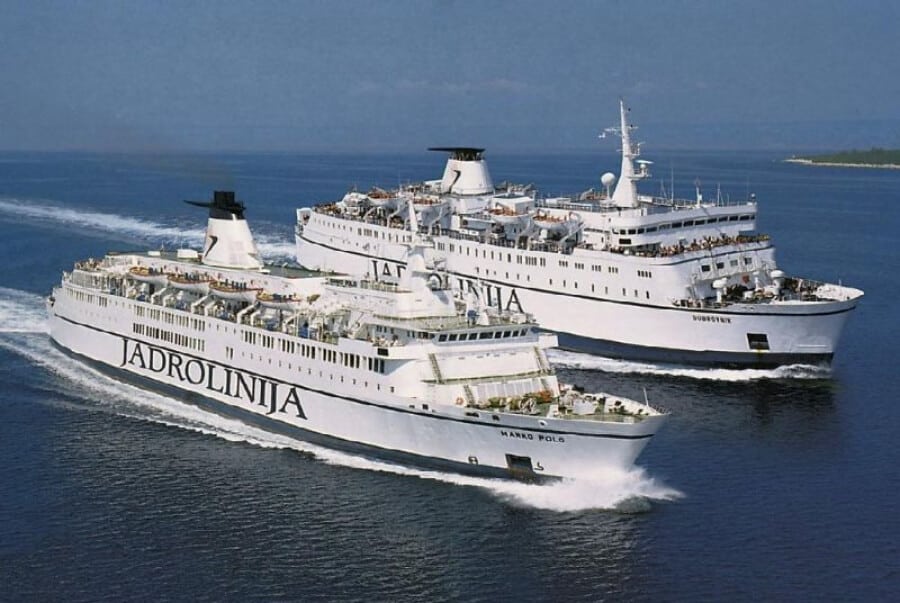
Jadrolinija
Luka Rijeka is the largest port in Croatia. Moving to Croatia? If you’re transporting your worldly belongings in a shipping container, they’ll likely come through here. Furthermore, Rijeka is the home city of Croatia’s largest passenger and car ferry company, Jadrolinija. Founded here in 1947, the state-owned company connects Croatian islands to the mainland. Consequently, it is also a major resource for tourists wanting to visit the islands and get around Croatia.
To the shame of Croatia’s entire tourism industry, to Jadrolinija, to the state that owns it and to the home city in which they’re still based, the company now only runs ferries from Rijeka to nearby islands. Specifically, Cres, Krk, Ilovik, Pag, Losinj, Rab, Susak and Unije. That wasn’t always the case.
Marco Polo, Rijeka to Dubrovnik RIP
Until 2015, the greatest public transport ferry cruise on the entire Mediterranean could be found in Croatia. Specifically, on the Marco Polo ship, Jadrolinija took passengers on a mammoth cruise between Rijeka and Dubrovnik. Furthermore, the ship stopped at some of Croatia’s most-famous destinations – Split, Hvar, Korcula and Mljet. It was an epic journey, a once-in-a-lifetime trip for visitors and loved by locals too. The ship was retired and never replaced. The line discontinued. In years to come, it will surely be remembered as the Orient Express of Adriatic seafaring.
Summer high speed line: Zadar to Rijeka, Rijeka to Zadar via Silba, Rab, Krk
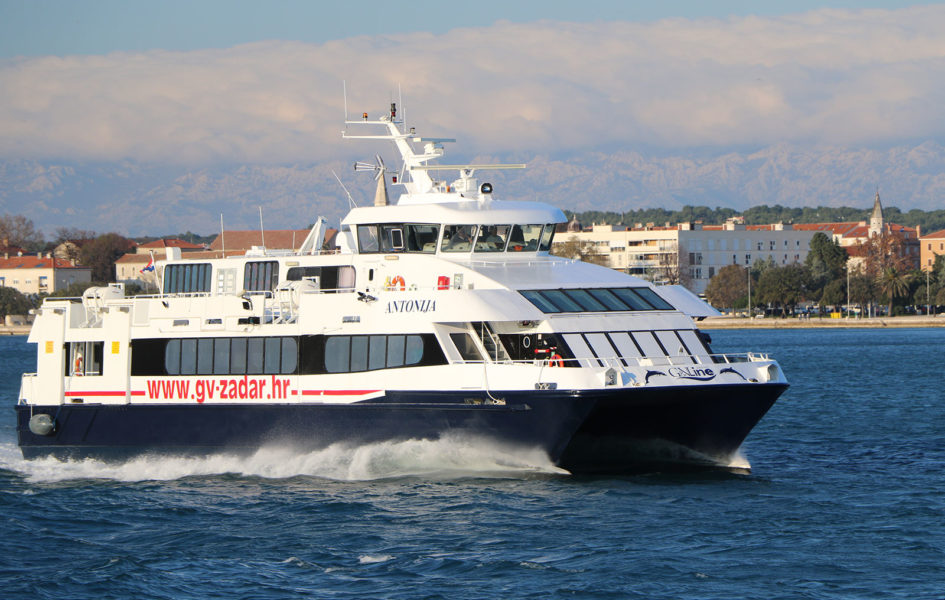
Only in the summer months, company G & V Line run a fast ship ‘Antonija’ from Zadar to Rijeka and from Rijeka to Zadar. Furthermore, the boat stops off at islands Silba, Rab and Krk along the way. Check out the timetable and buy tickets here.
Train
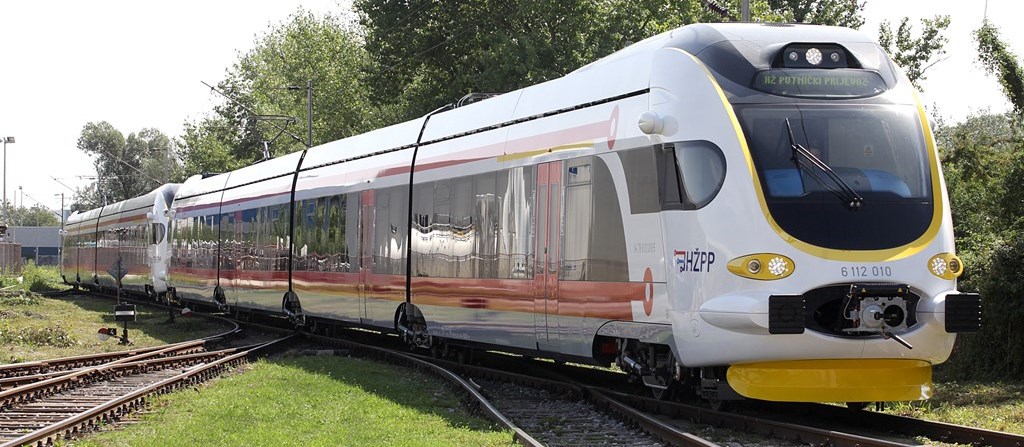
Rijeka on the pan-European fast trains network RH2
After Zagreb, Rijeka is the city best connected by rail in Croatia. Rijeka is connected to the fast pan-European train network. In fact, it’s possible to travel from Almeria on the south-east Mediterranean coast of Spain, through Madrid, Barcelona, Marseille in France, northern Italy and Slovenia to Rijeka. Furthermore, this same RH2 line then continues to Budapest, Hungary via Zagreb, before finishing in Záhony in the east of Hungary, not far from the border with Ukraine. Wow. Read more about the cross Europe train network and how it connects to Rijeka here.
Prague, Czech Republic to Rijeka and Split via Zagreb
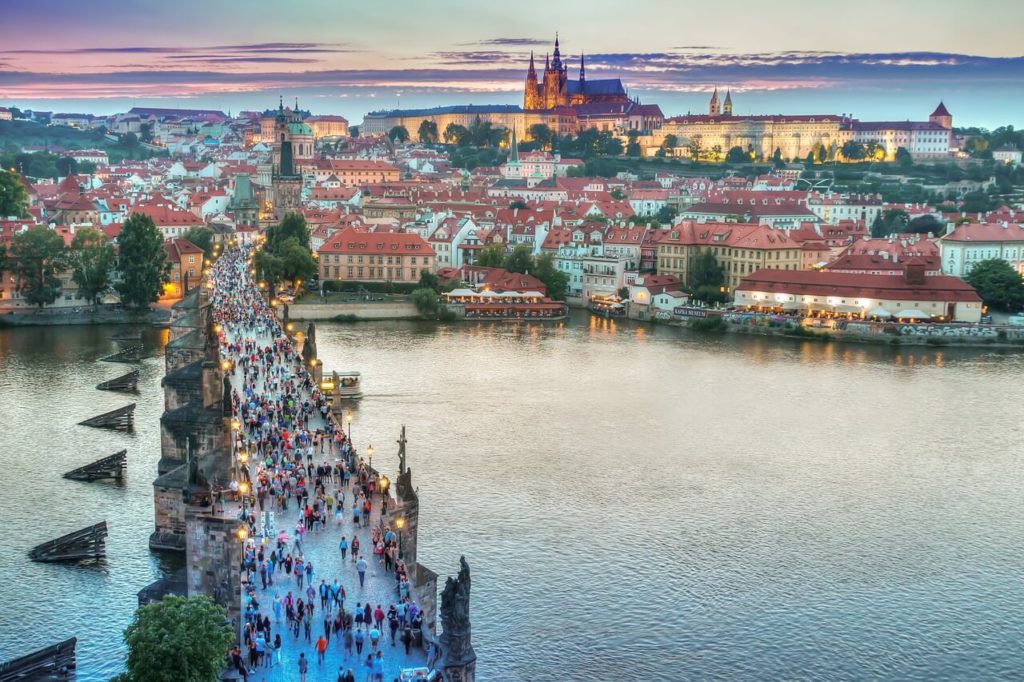
Another international train route to Croatia runs from Prague, Czech Republic to Rijeka and Split via Zagreb. Run by RegioJet, the train also goes through Ogulin in Karlovac County. Ogulin is also the station you want to head to from Rijeka if you want to go from Rijeka to Plitvice Lakes National Park by train. You can find out more about the Prague, Czech Republic to Rijeka and Split via Zagreb line and buy tickets here
Croatia trains
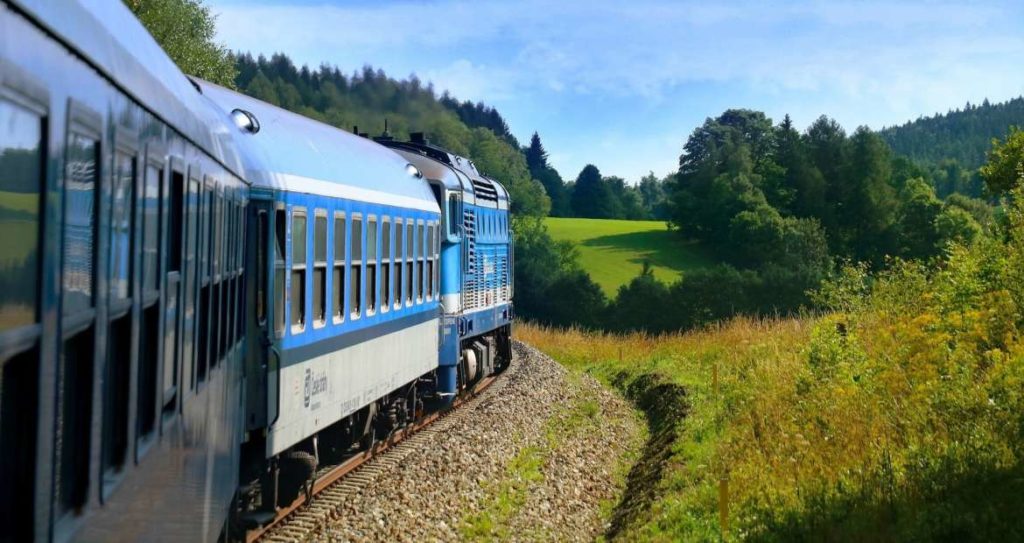
You can travel from Rijeka to anywhere in Croatia by train. The national carrier has all the details, the website is in English and you can buy tickets online. Do it here. It’s rarely the fastest way to travel in Croatia. But, it is one of the most comfortable. Moreover, the views can be lovely. And, you will probably meet some folks who insist you drink with them if it’s an overnight journey!
Bus
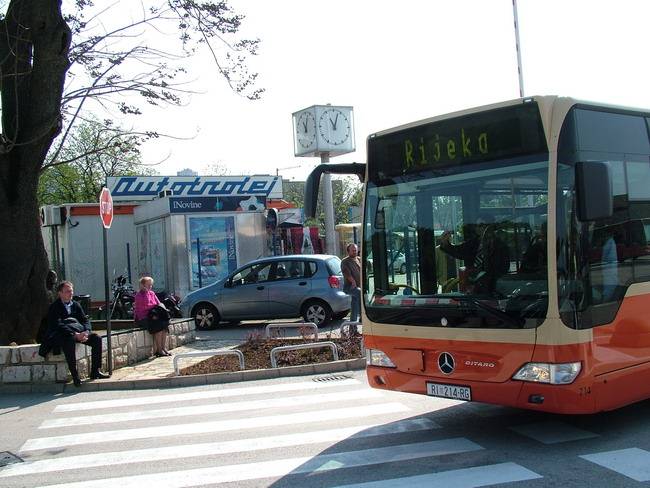
Rijeka has two bus stations. Generally, the one for intercity and international travel is referred to as Rijeka Bus Station. Find it at 1 Trg Žabica 51000 Rijeka. Travelling intercity by bus in Croatia is a fast, popular and reliable option. Learn more about it here.
The other bus station is for the orange-coloured local carrier, Autotrolej. They’re the ones to look for to get to the beach, for visiting Trsat, Rijeka university campuses and city neighbours that are a steep walk upwards. You can pick up every line in the city centre. But, if you need the station for local buses itself, find it at 15 Školjić 51000 Rijeka. Find out more about Autotrolej lines, timetables, ticket offers and buy tickets from their great website here.
Road, by car
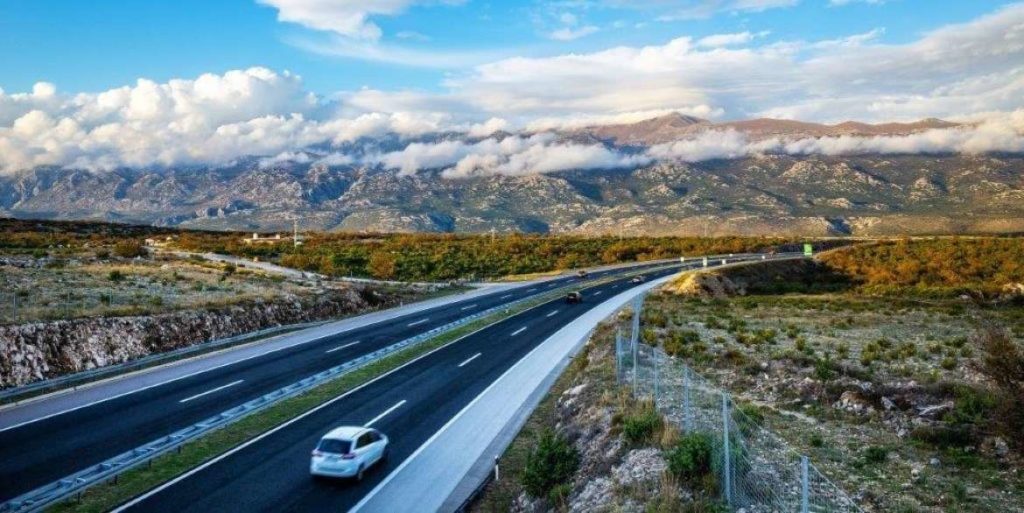
Rijeka is located just off the main motorway from Zagreb to Istria. The descent to the city is spectacular! Once in the centre, be aware there’s a one-way system. However, parking is plentiful. And you can pay by SMS parking. Just look for the parking sign and it will give you the number to text.
Thanks to Croatia’s great motorway network, Rijeka is well connected to all of the country. The aforementioned A6 Zagreb-Rijeka lets you continue to eastern or northern Croatia. Istria is connected to the city through the Učka tunnel and then by the so-called Istrian Y.
If you want to get from Rijeka to Dalmatia, there are several options. Firstly, you can take the A6 towards Zagreb and then, in Bosiljevo, turn onto the A1 motorway towards Split. While this is the longest and most expensive route, it’s actually one of the fastest. And the safest. Alternatively, you can go south down the coast from Rijeka, cut in at Senj and then go towards Žuta Lokva. There, you’ll again merge onto the A1. Or, if you have a lot of time and a lot of patience, for a joyride, go all the way down the coast road, on the so-called Jadranska magistrala (D8). If you get bored of the scenery (difficult), you can always cut onto the A1, maybe at Zadar, to speed up your journey.
Looking for a fast, reliable and trouble-free transfer to or from Rijeka? Contact TC transfer partner Adriatic Transfers for your one-stop solution.
Day trips and travel from Rijeka: to Venice, to Dubrovnik, Trieste, to Zagreb, Plitvice, Opatija, Islands
Trieste and Venice
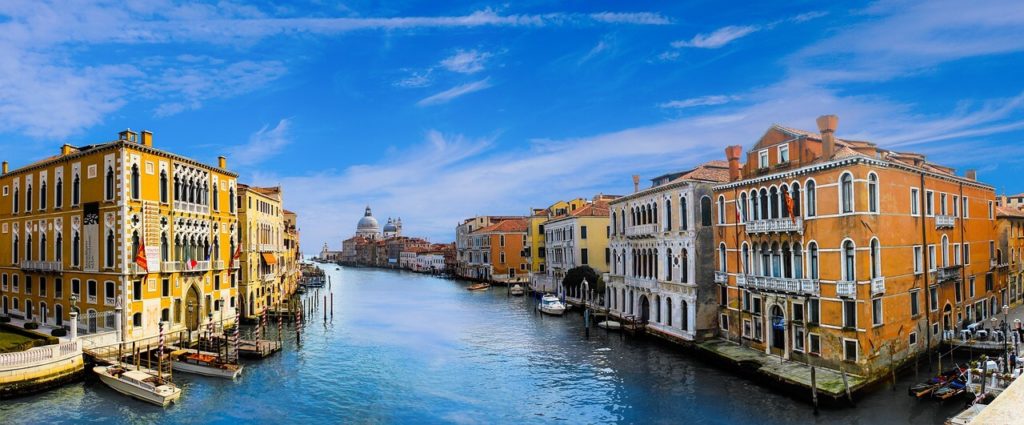
Sadly, no boat currently runs across the Adriatic between Rijeka and Venice. By all means, you can still make the journey, if your heart’s set on including the two cities on one trip. But, you’re looking at a car ride, private transfer, bus via Trieste or train journey. By train, go from Rijeka to Pivka in Slovenia (2 hours), change there for Trieste (1 hour 20), where you change again for Venice (2 hours). There are only one or two trains a day between Pivka and Rijeka, so if you’re going to do this, plan carefully.
Opatija
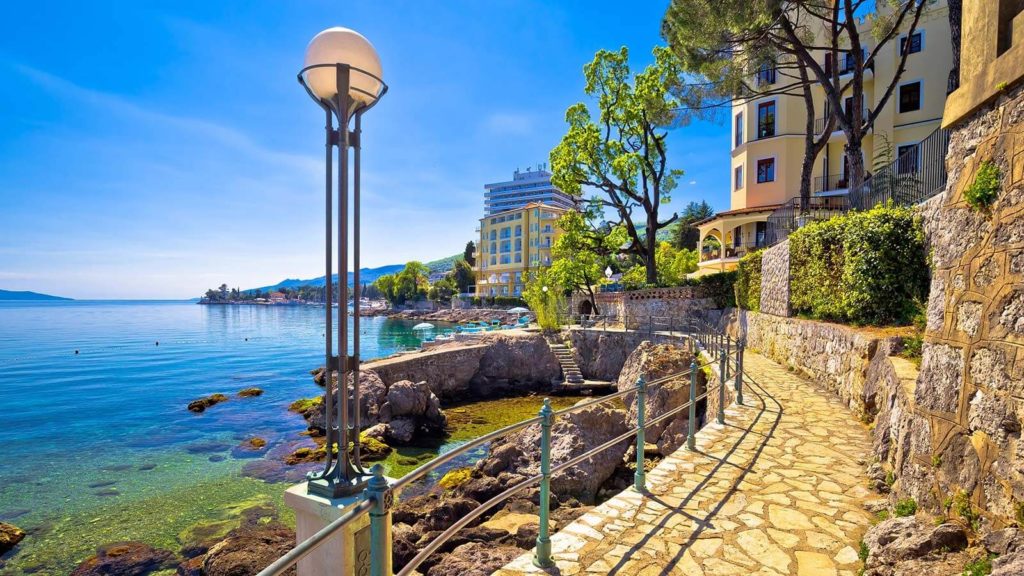
For reasons touched on earlier, Opatija and Rijeka are inextricably linked. Indeed, if you’re after any day trip from Rijeka that’s not all-about-the-beach, Opatija should be top of your list. Opatija is like Rijeka, full of incredible Austro-Hungarian architecture and finery. But, without the industrial bit. In the place of towering cranes are beautiful ornamental and terraced gardens. Instead of warehouses, factories and concrete, a long seaside promenade built for two. For nightlife seekers, this is not the place. For backpackers and a family with teenagers, a day trip is all it takes. But, for a romantic couple celebrating a honeymoon or anniversary? You’ll not want to leave. Read more about fabulous Opatija in our detailed guide.
Plitvice Lakes National Park
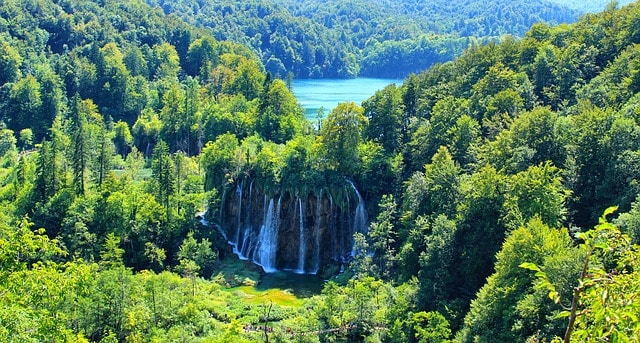
Croatia’s most famous National Park, everyone wants to see the gushing waterfalls and cascade of pools at Plitvice. You can reach it from Rijeka by train, bus, car, private transfer or organised tour. Find out more about the park here.
Zagreb
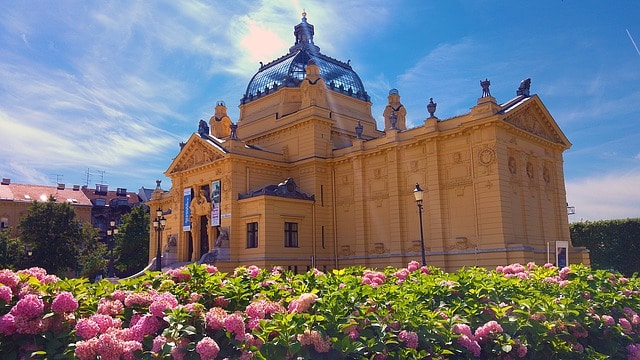
It looks a way inland, but actually, Zagreb is only a couple of hours drive from Rijeka. And, the Croatian capital is a must-see. Not only is it the centre of business and commerce, but also of art, culture and so much more. Get all you need to know here.
Dubrovnik
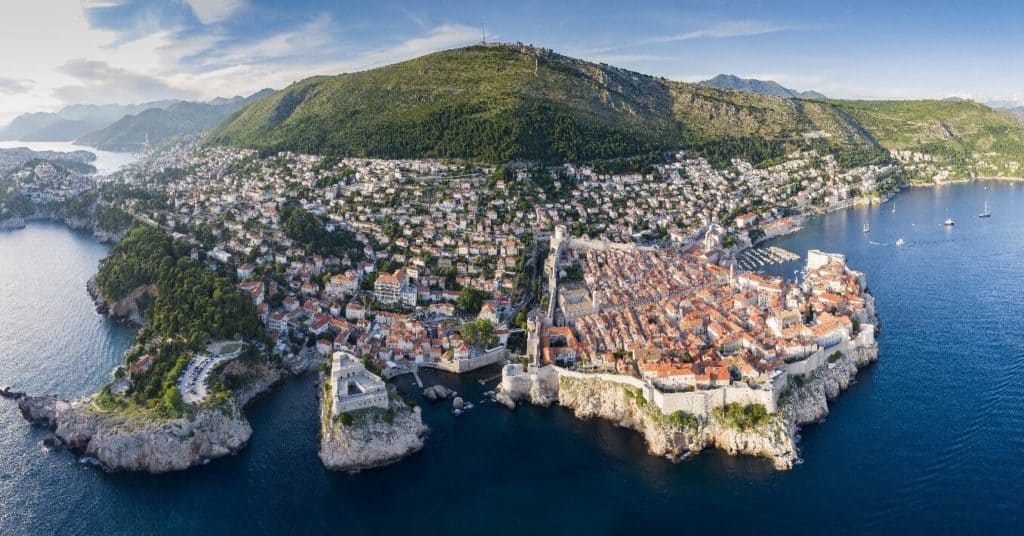
The famous walled city of Dubrovnik is so far south of Rijeka, it would be incredibly unwise to consider it appropriate as a day trip. It is doable. In fact, there are regular flights from Rijeka to Dubrovnik. But, there’s too much to enjoy in the southern city for a quick bolt and back by plane. Read up on the Pearl of the Adriatic and then decide if you instead fancy it as a weekend excursion.
Islands: Cres, Silba, Rab, Krk, Ilovik, Pag, Losinj, Rab, Susak, Unije
Croatia is not short on islands to visit (take a look at this dedicated page and hub for an overview). All of those listed above are easily accessible by ferry or catamaran from Rijeka. In fact, you don’t even need a boat to visit the nearest, Krk. There’s a bridge. Just remember, the further you travel for your island day trip, the shorter the time you might get to spend there.
Rijeka Football (soccer)
Football is a big deal in Rijeka. In fact, the first football match in Croatia was played here, in 1873. The city’s premier club, HNK Rijeka, was founded back in 1946 as Sportsko Društvo Kvarner (Croatian) / Società Sportiva Quarnero (Italian). Shortly afterwards (1954) it became HNK Rijeka.
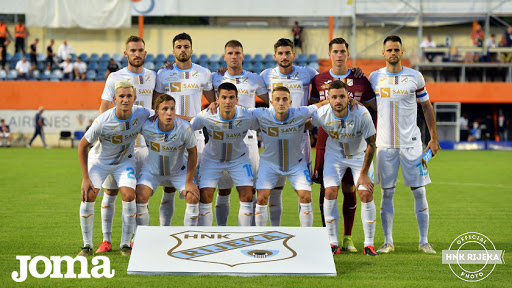
Football is the most popular sport in Croatia. In fact, the ever first football match in Croatia was played here, in 1873. And, the city’s HNK Rijeka is one of the country’s top 4 clubs (alongside Dinamo Zagreb, Hajduk Split and NK Osijek). Furthermore, they are the third-most successful Croatian football club. In fact, they’ve won one Croatian First League title, two Yugoslav Cups, six Croatian Cups, one Croatian Super Cup and the 1977–78 Balkans Cup.
The club has competed in European UEFA competitions no fewer than 20 times. Indeed, around half of those instances have come in the last decade. Subsequently, the team has helped put the city on the international map. Their fan group is called Armada.
Kantrida
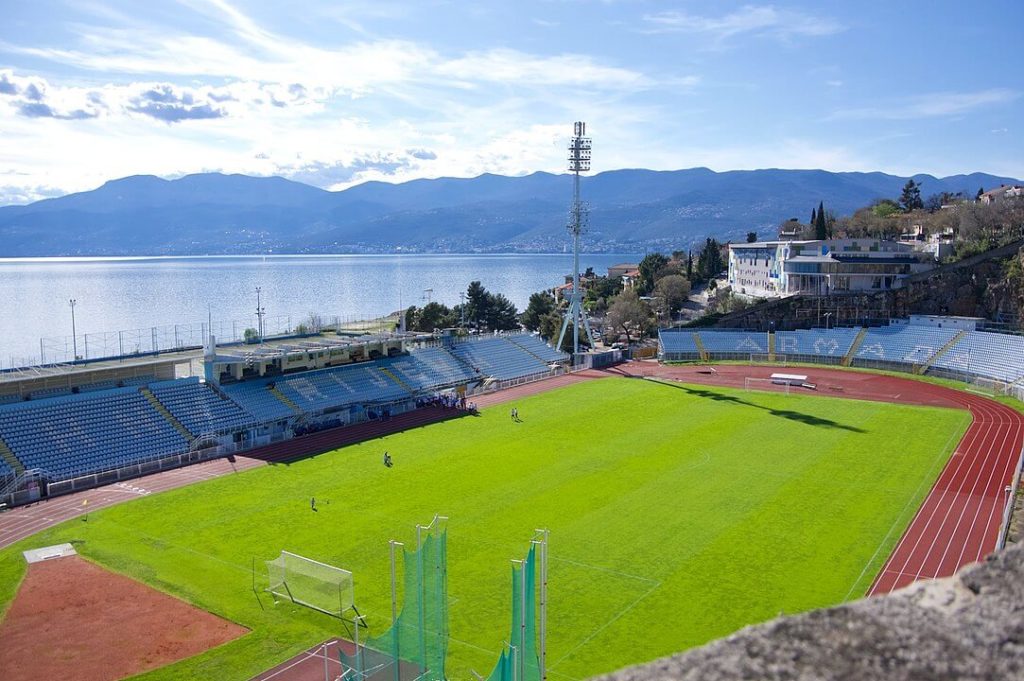
Notably, HNK Rijeka’s old stadium, Kantrida, was one of the few top-flight football stadiums in Europe where you could see the sea from the stands. Iconic. The stadium is currently being rebuilt. While this happens, the team play in the temporary home of Stadion Rujevica. Once rebuilt, the new state-of-the-art Kantrida will have an increased capacity of 14,438. Yay! However, according to current plans, it will hold no sea view. Boo!
Study in Rijeka: University for International Students
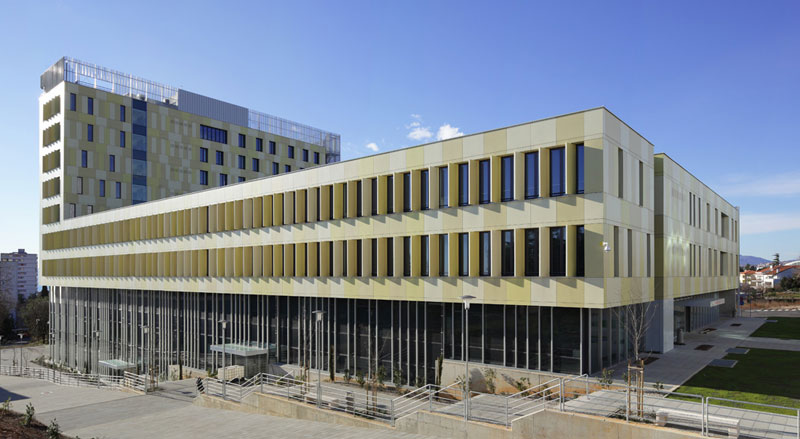
A seat of higher education for hundreds of years, the foundations of Rijeka university can be traced back to the 18th century. Today, Rijeka university has nine faculties, one art academy and four departments.
Its incredibly famous Medical Faculty was established in the 1950s. Moreover, it was partially set up by Dr Andrija Stampar, one of the greatest Croats of the last century. Specifically, he pioneered public health across the globe and helped found the World Health Organisation.
Rijeka is a great place to go to uni. And, you can find English language courses in each of its faculties and departments. More info here.
Healthcare and Wellness in Kvarner
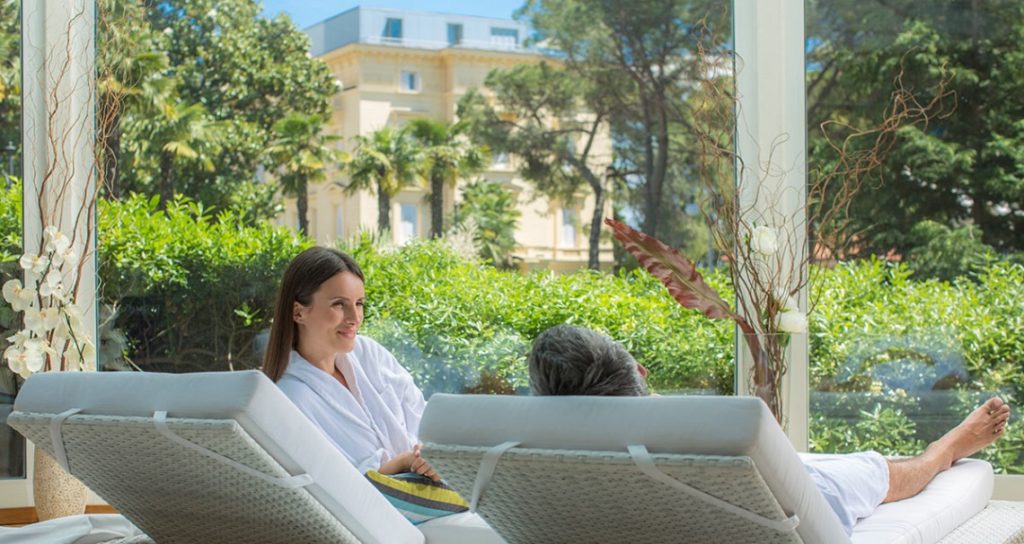
The prestigious medical faculty of Rijeka University is not the only reason this region is associated with health and wellness. In fact, Kvarner’s history as Croatia’s first international tourist destination is linked to it. Nearby Opatija was renowned for it mild year-round climate and restorative sea air. Around these natural properties grew a range of accompanying health and wellness options.
The tradition of health and wellness continues in Opatija today. Specifically, several hotels offer different spa and therapy treatments. But, the industry has nowadays expanded to include medical procedures. Furthermore, it has outgrown Opatija and can now be found across multiple sites in the Kvarner region.
Interesting facts about Rijeka: Torpedoes, Che Guevara, Pet Cemetery + more
Torpedoes
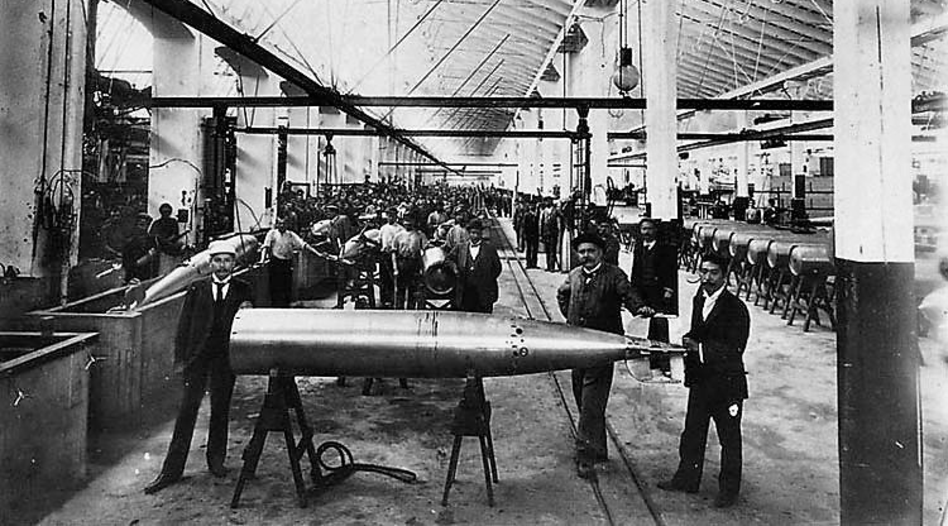
Over 150 years ago, the first prototypes of the self-propelled torpedo were developed in Rijeka. The mastering of the project was undertaken by Ivan Blaž Lupis Vukić (Giovanni Luppis, in Italian) in collaboration with an English engineer, Robert Whitehead (from Bolton, near Manchester). After their success in perfecting the prototypes, the world’s first torpedo factory was established here. Moreover, it produced the weapons right up until 1965.
Che Guevara
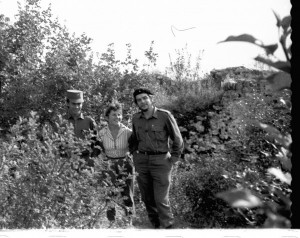
Argentine Marxist revolutionary and a key figure of the Cuban Revolution, Che Guevara made an official diplomatic visit to Rijeka in 1959. Among other places, he visited the 3 Maj shipyard and Trsat castle.
Kozala Cemetery and Rijeka Pet Cemetery
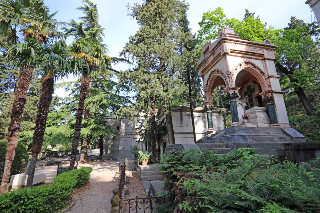
As mentioned, there aren’t many parks or green spaces in Rijeka. In fact, one of the city’s best green spaces is actually Kozala cemetery. It’s the fourth oldest communal cemetery in Europe and holds the remains of persons of many different faiths. Significantly, surnames of some of its residents can be seen written in Croatian, Hungarian, Italian, French, English, German and Latin. Its biggest and grandest mausoleum was built for Robert Whitehead.
Also in Kozala is Croatia’s only pet cemetery. At over 115 years of age, it’s Europe’s third-oldest.
Filming in Rijeka
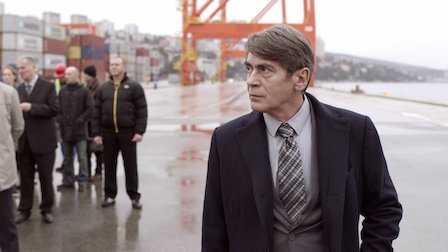
Salma Hayek was filmed in the city for the 2021 movie ‘The Hitman’s Wife Bodyguard’. But, she’s not the first to have used the city as a film set. Ralph Fiennes was here recently to film the 2018 movie White Crow, about ballet dancer Rudolf Nureyev. Also, the city forms an essential backdrop to the TV show ‘Novine’ (The Newspaper). Now in its third season, it was the first Croatian-language series to be aired on Netflix and was shown around the world.
Souvenirs: What to buy
Looking to take something home that is unmistakably Rijeka? Further to the aforementioned Kisha umbrellas, there are some other great options.
BuRa Design Store
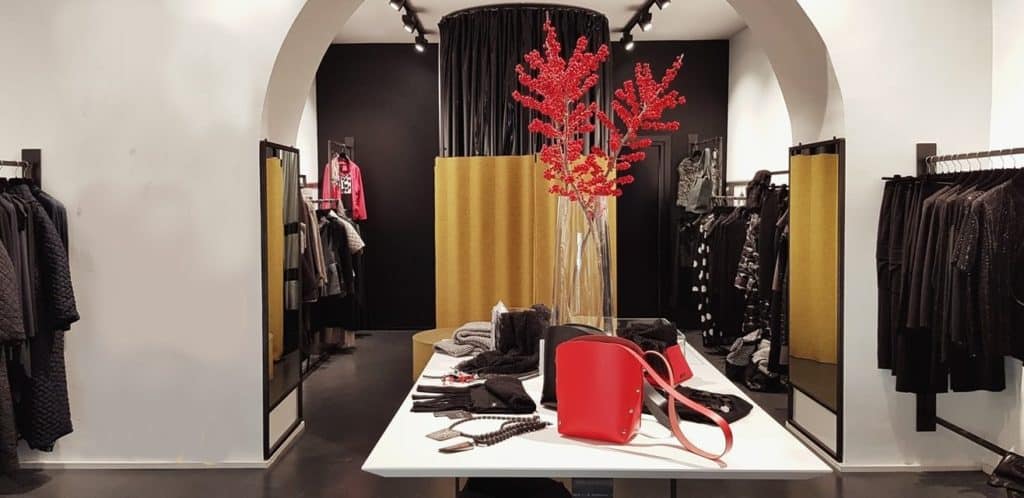
Cool, city centre fashion boutique BuRa sells exclusively Croatian-designed goods. Elegant dresses and ladies bags in the main. But, there are funky, modern necklaces, accessories and some home design stuff too.
Šta da?
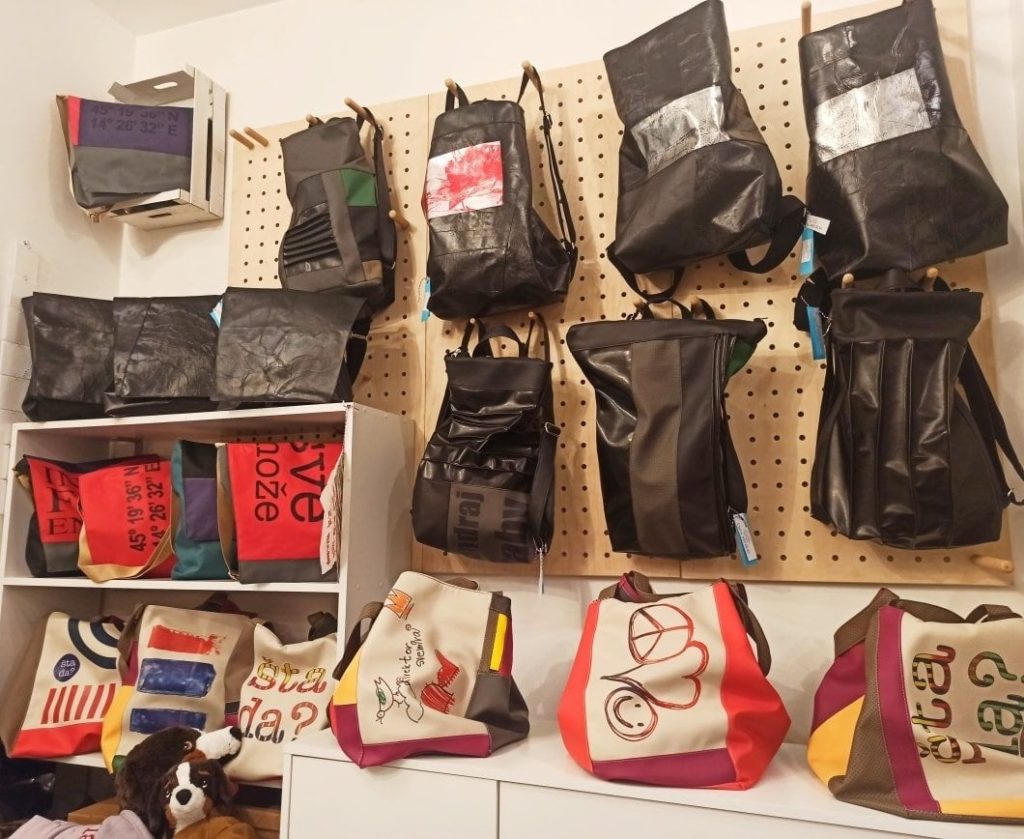
Šta da’s owner, Amna Šehović has a passion for recycling. She makes bags and accessories from found and reclaimed materials. Additionally, this is a great place to pick up t-shirts specific to the city.
Other souvenirs from Rijeka
Be warned: There is a symbol of Rijeka, widely used on souvenirs and jewelry, that almost all visitors rightly greet with absolute horror. No, we won’t picture it. But, you’ll know it the moment you see it.
‘Morčić’ is a mythical figure with the grossly caricatured features – wide nose and charcoal black skin – of a sub-Saharan African who inexplicably wears a supposedly Turkish turban. Yeah, we know. That feeling of being trapped back in the 1970s just came back, didn’t it? Actually, this embarrassing and incredibly confused amalgam of ‘foreign’ has been a symbol here for many more years.
Some say Morčić’s legend stems from the story of a released slave, others from the battlefields of the hated Ottomans. Neither origin story is nice. Avoid. If you are offered one, don’t say “Oh my! That’s really rather racist!” You’ll offend unnecessarily. Just say “No, thank you. Doesn’t quite go with my dress/jacket/wallpaper” If someone is kind enough to give you one of these, they’re being nice. Don’t laugh in their face or throw up. Be respectful, courteous and grateful. You can throw it in the sea when nobody is watching. Or, put it in your suitcase for later disposal (and pray your luggage isn’t searched by a black customs officer on your home journey).
Rijeka’s two-headed Eagle
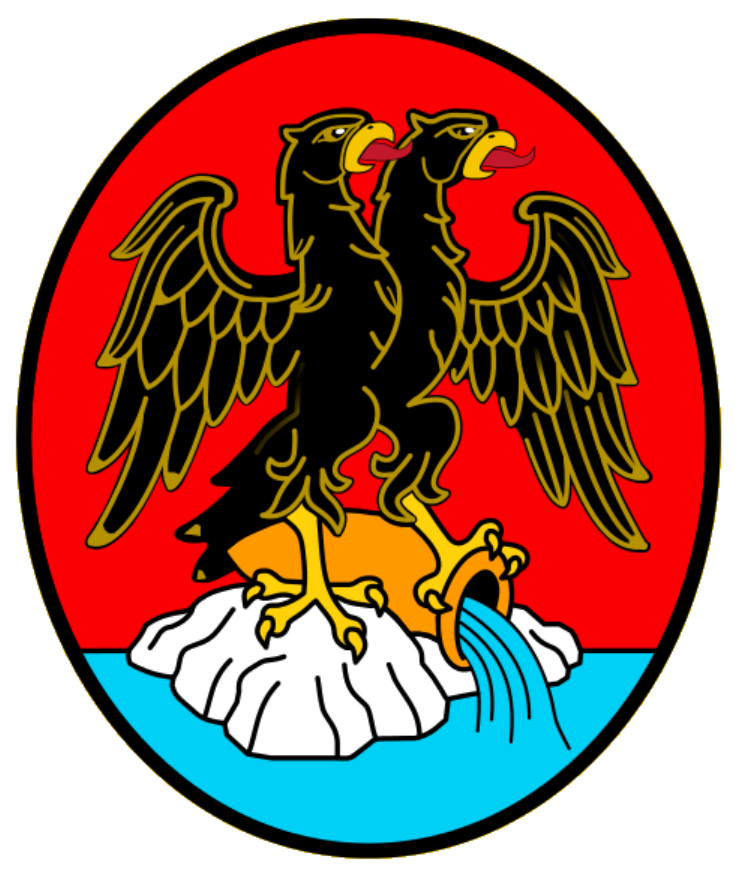
Luckily, there’s another symbol of Rijeka that’s not at all offensive. And, it’s really cool. Approved in 1659 as part of Rijeka’s coat of arms by Emperor Leopold I, the two-headed eagle has been a symbol of the city ever since. In fact, you’ll see it, newly restored, above Rijeka city clock tower on Korzo. Moreover, you’ll also now find it on t-shirts and accessories.

